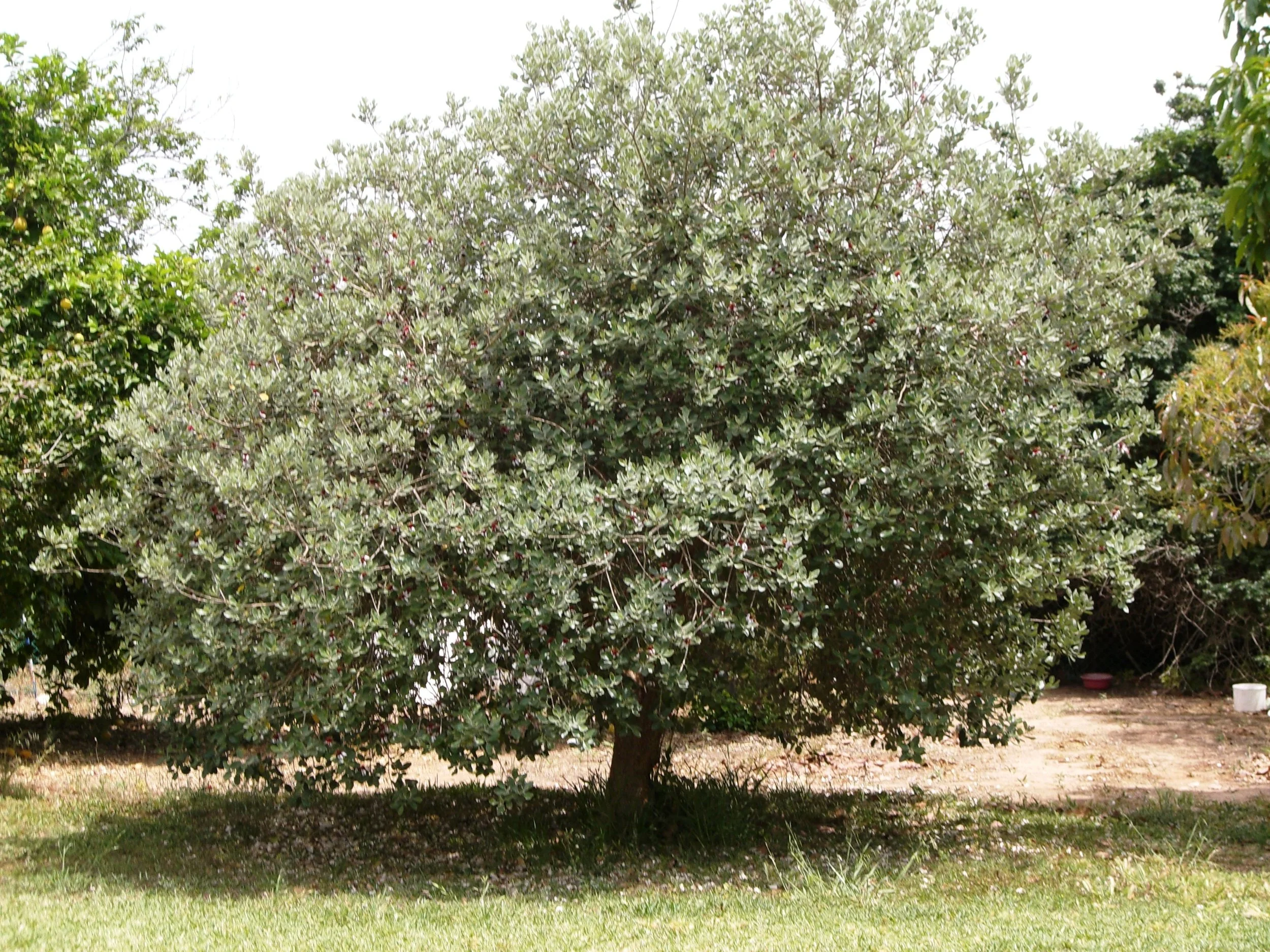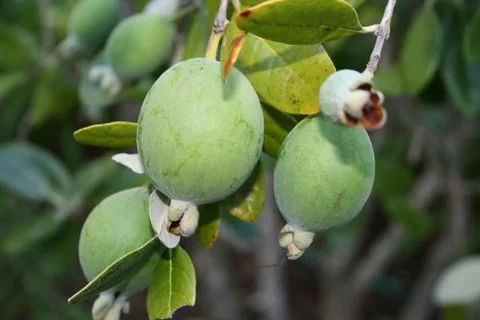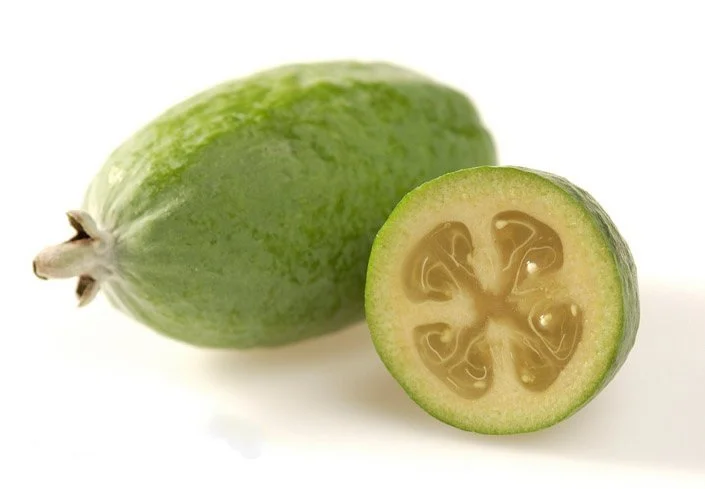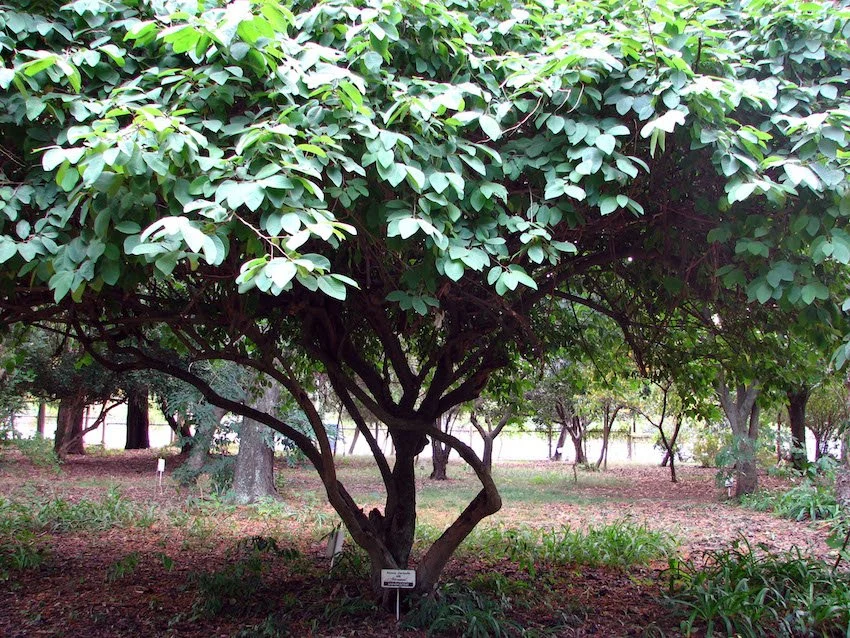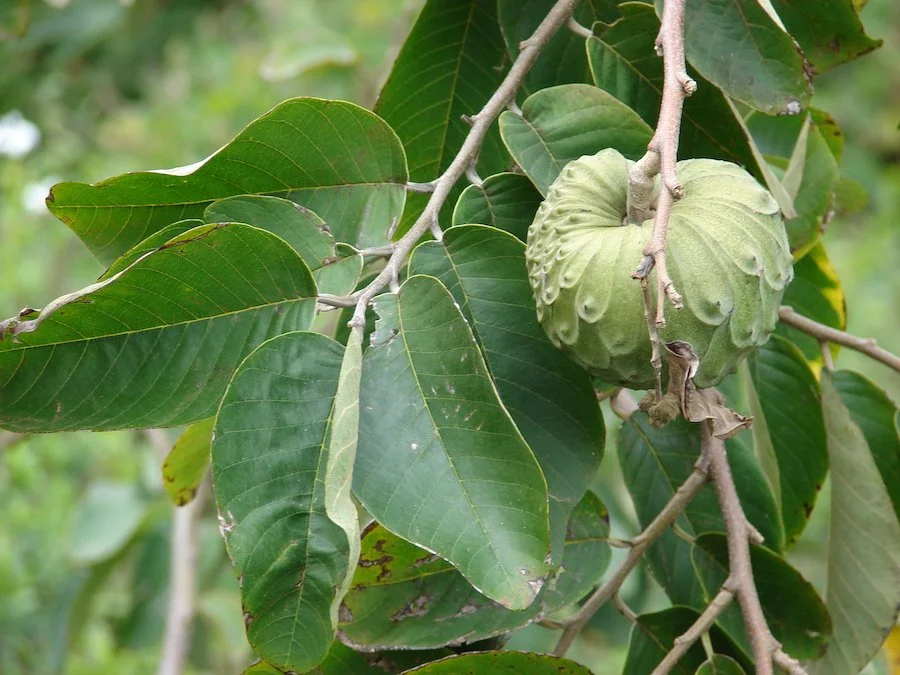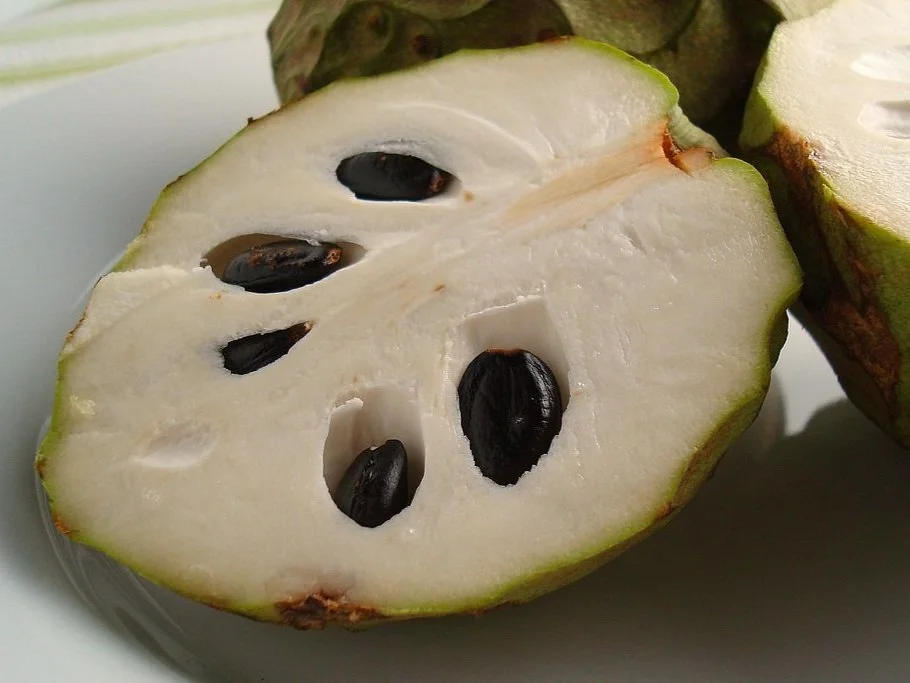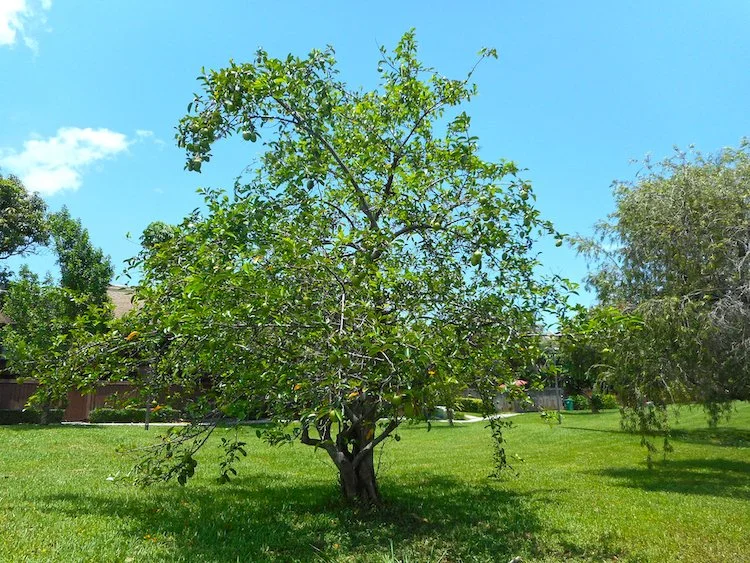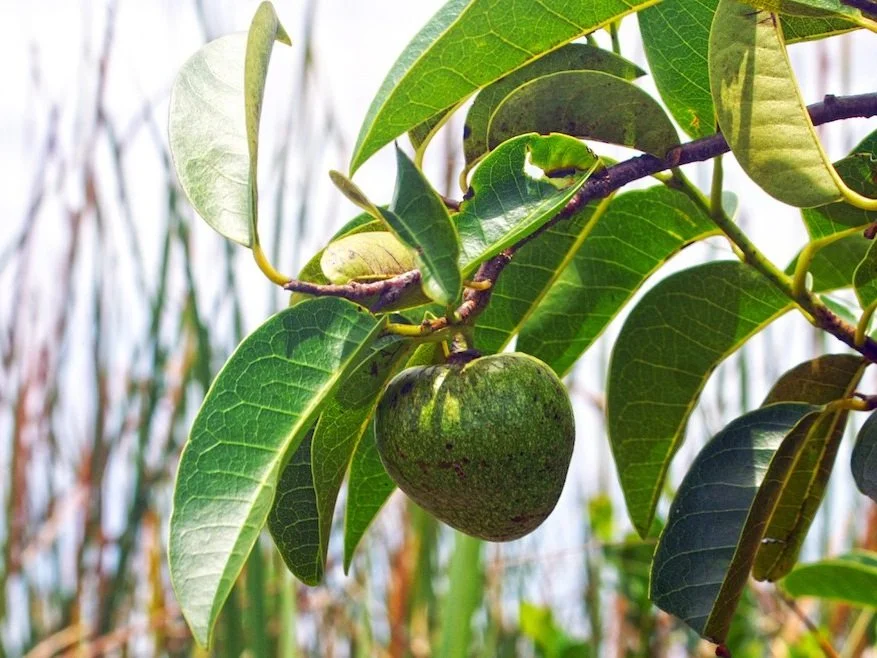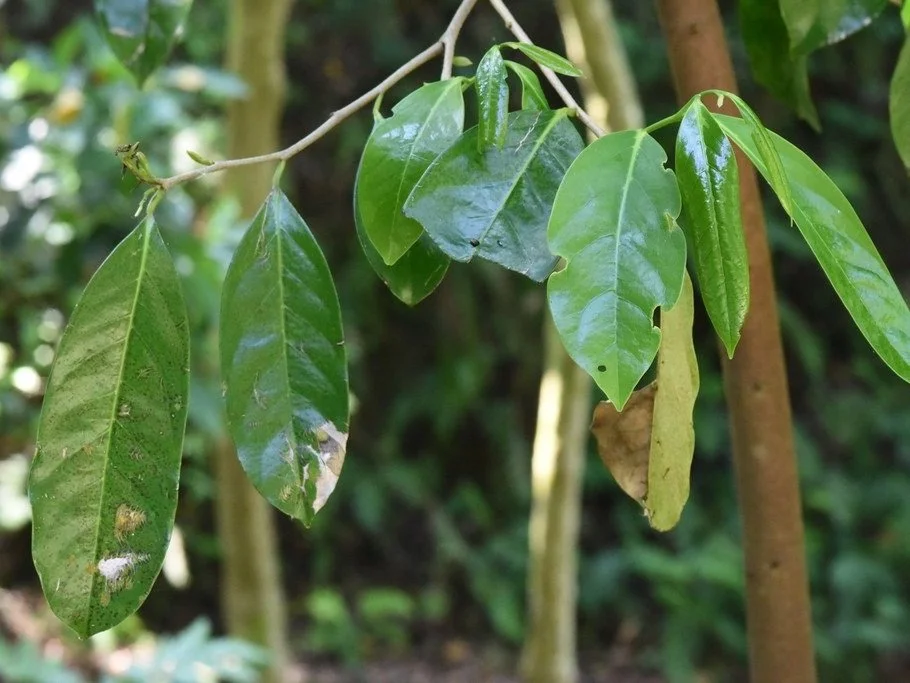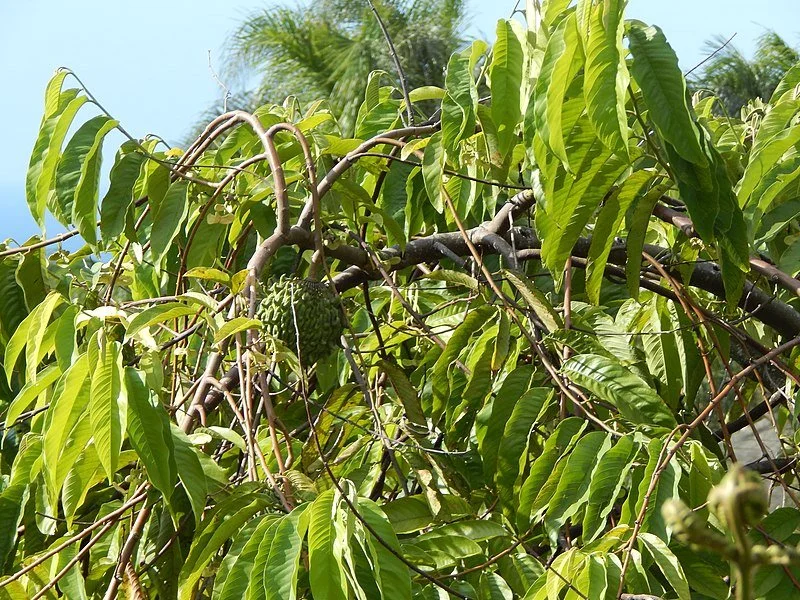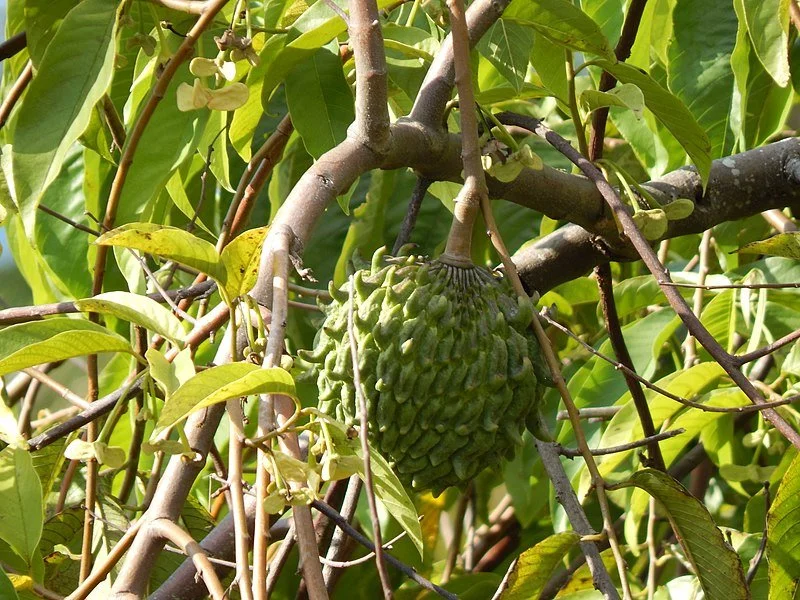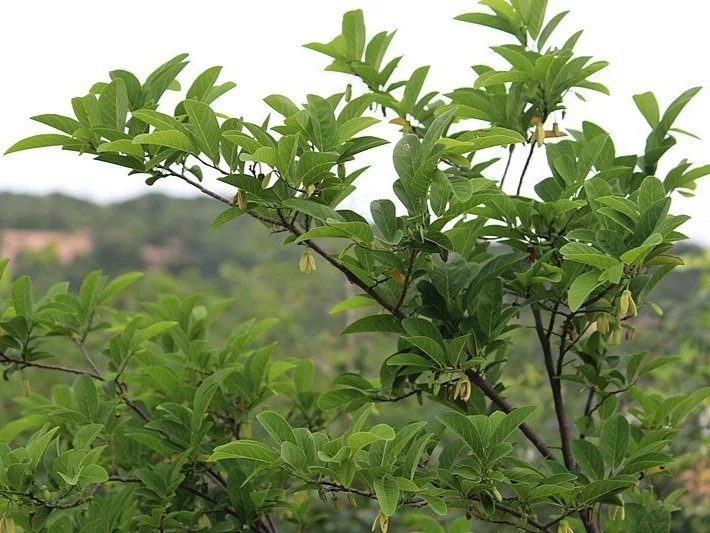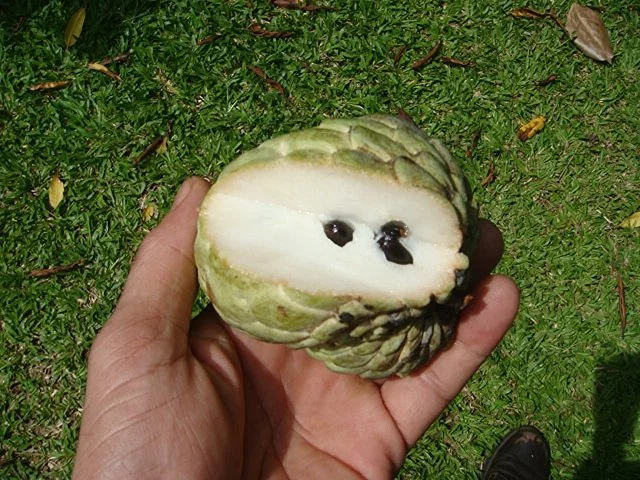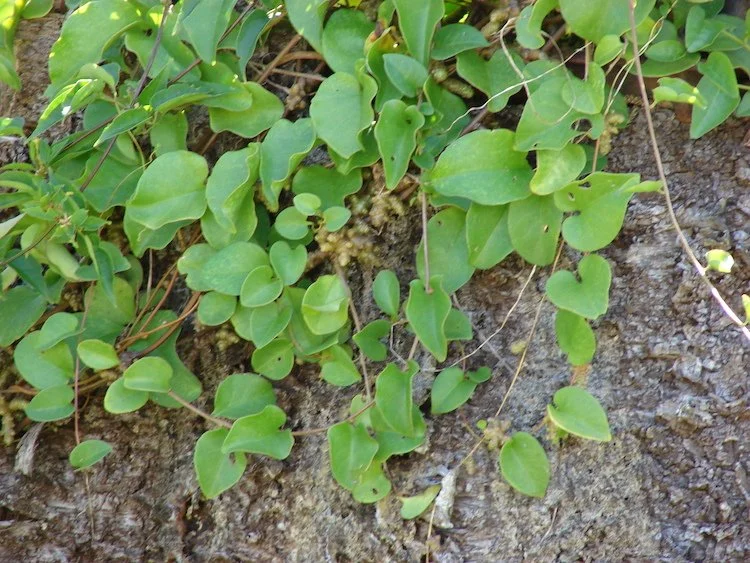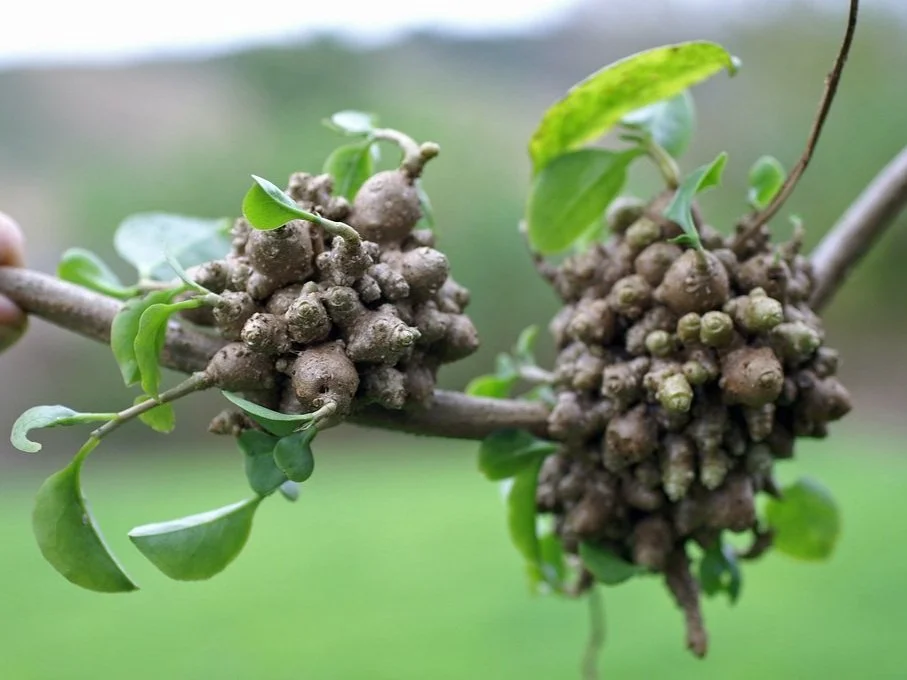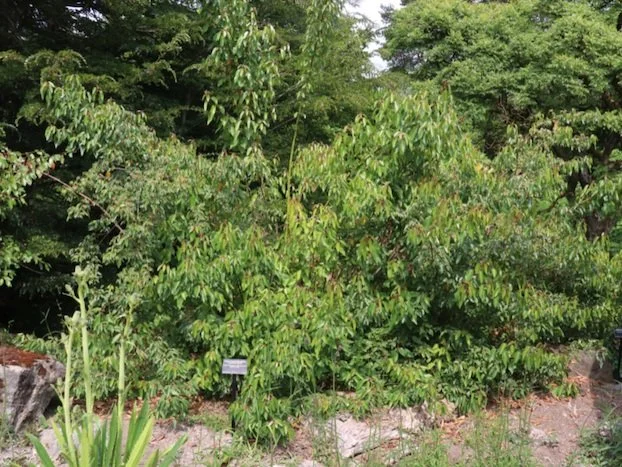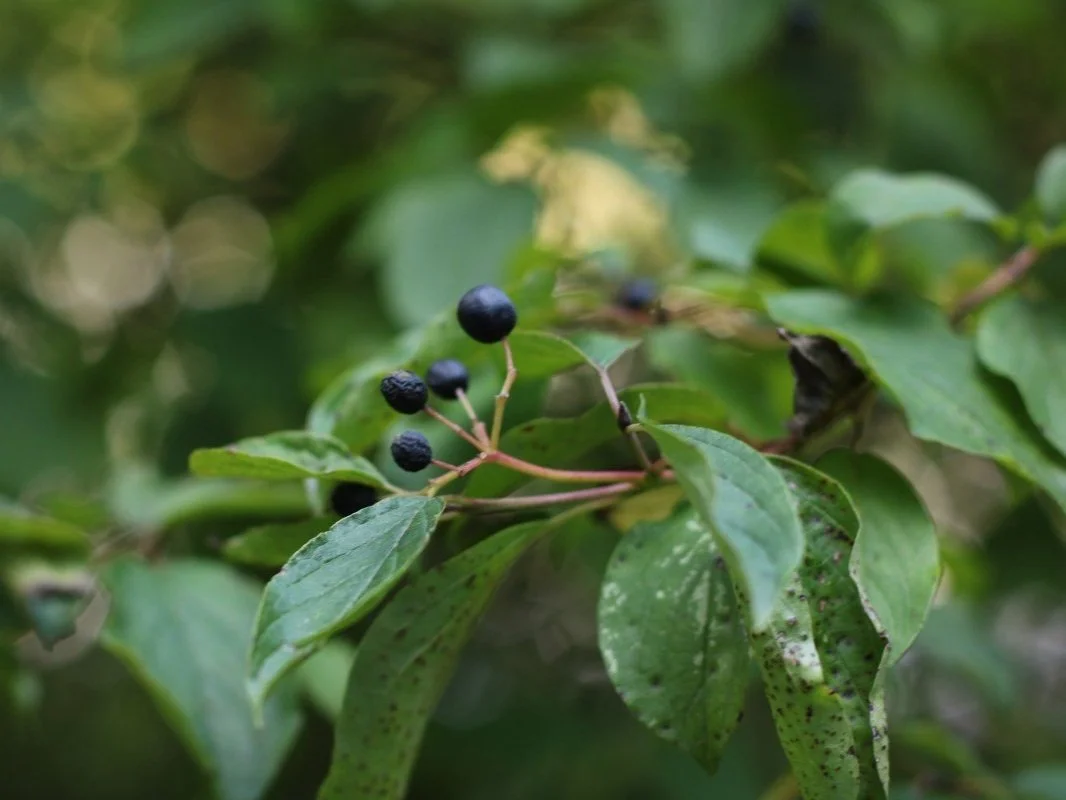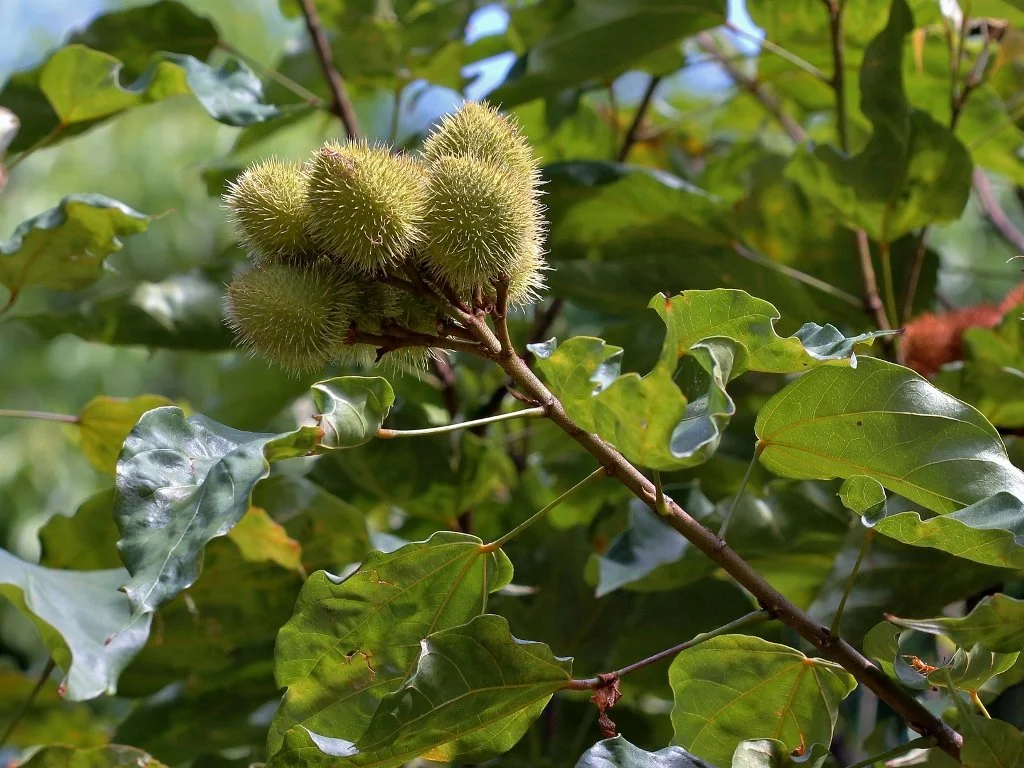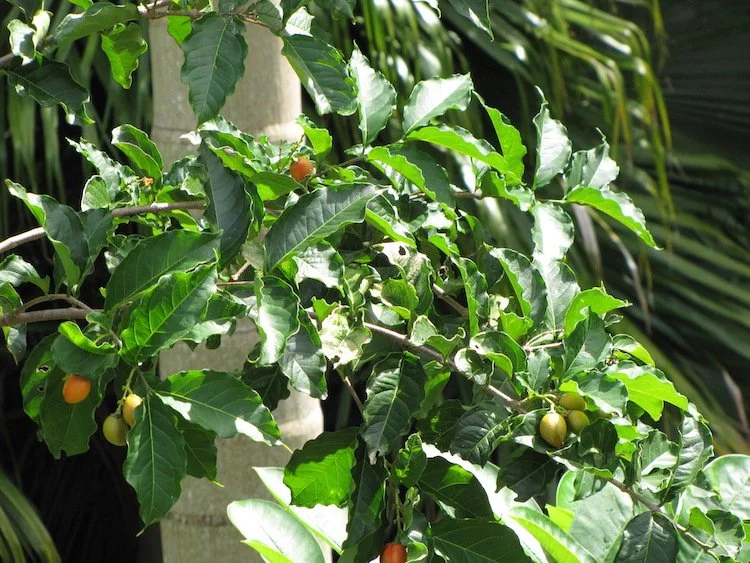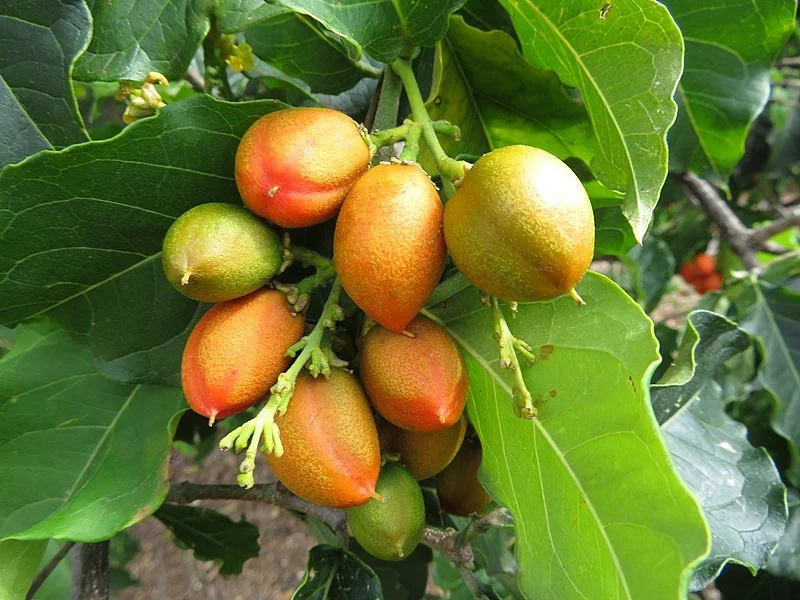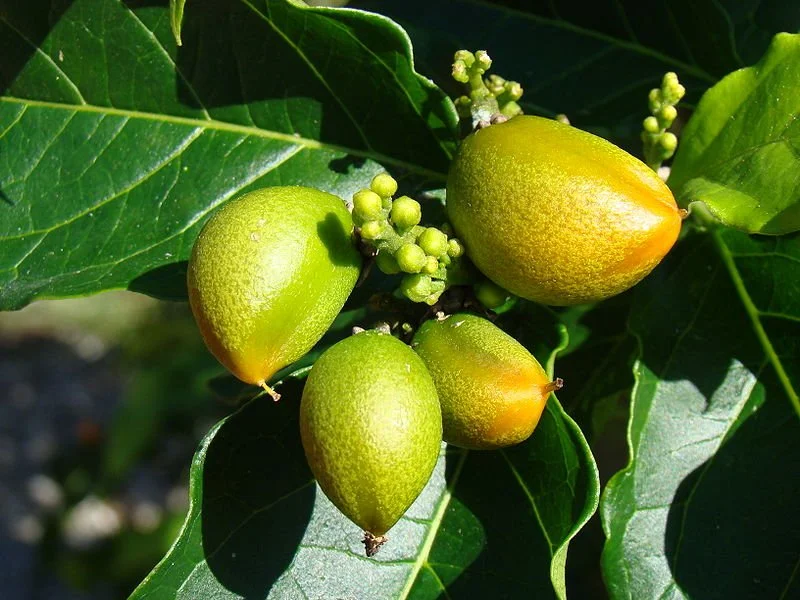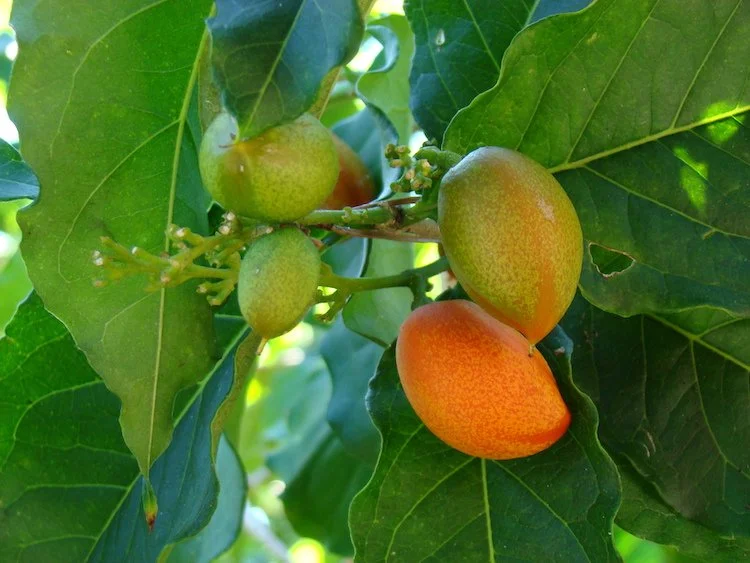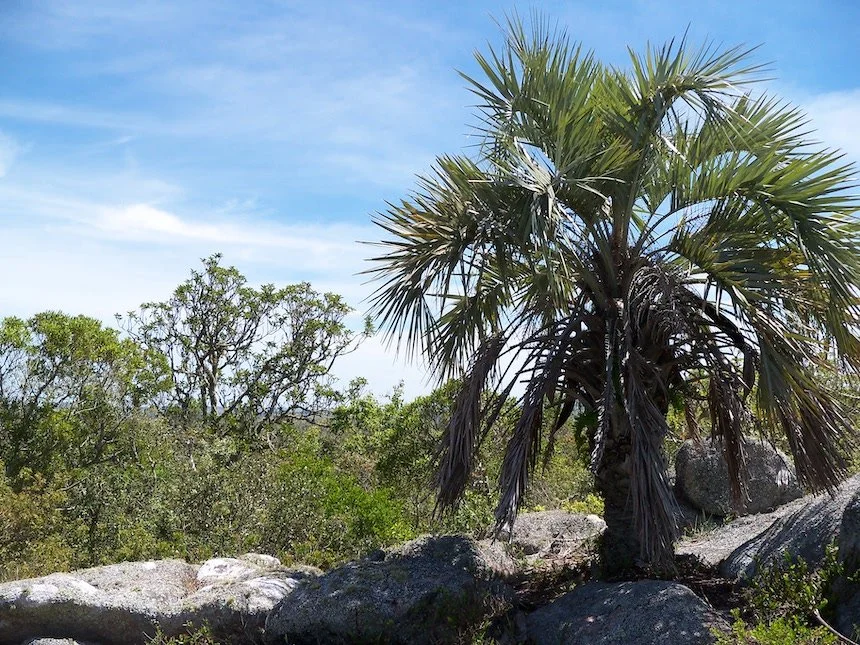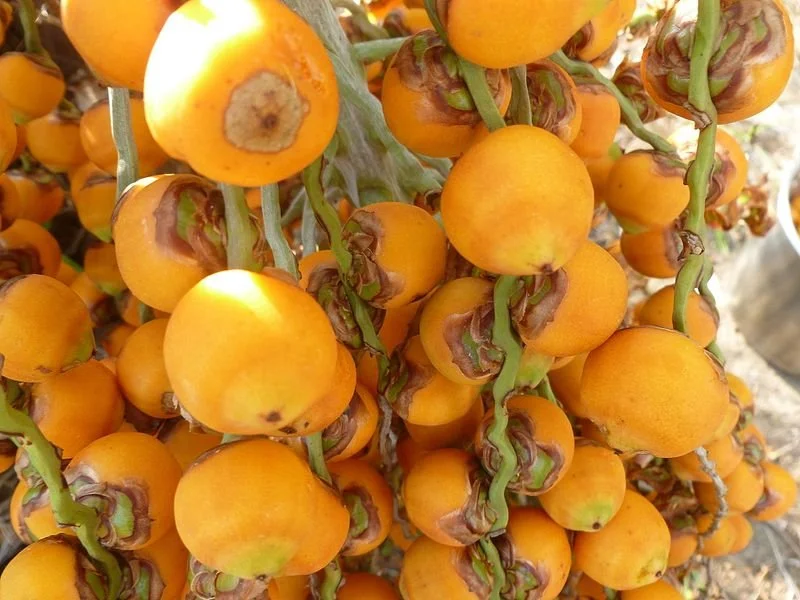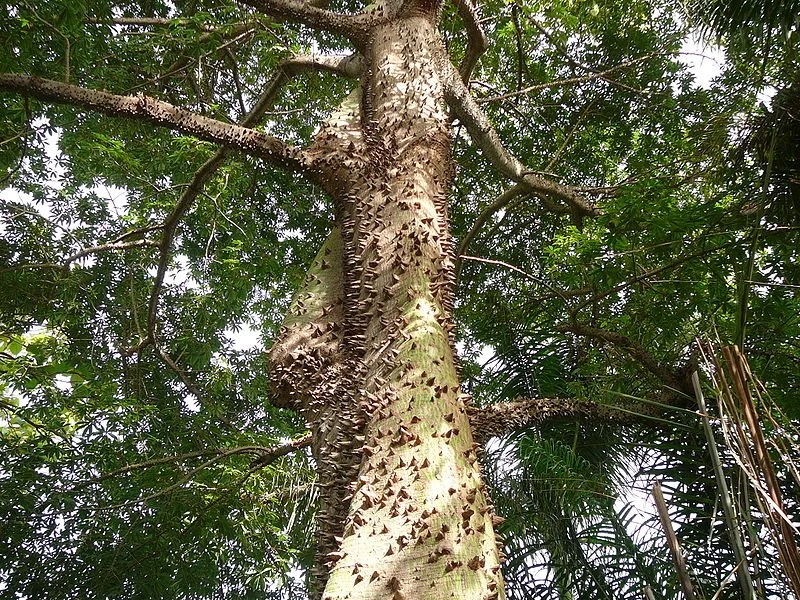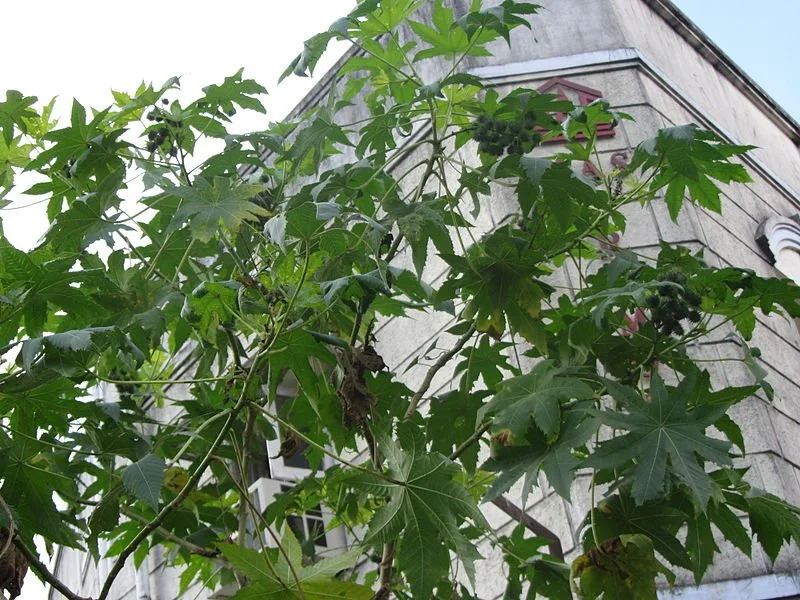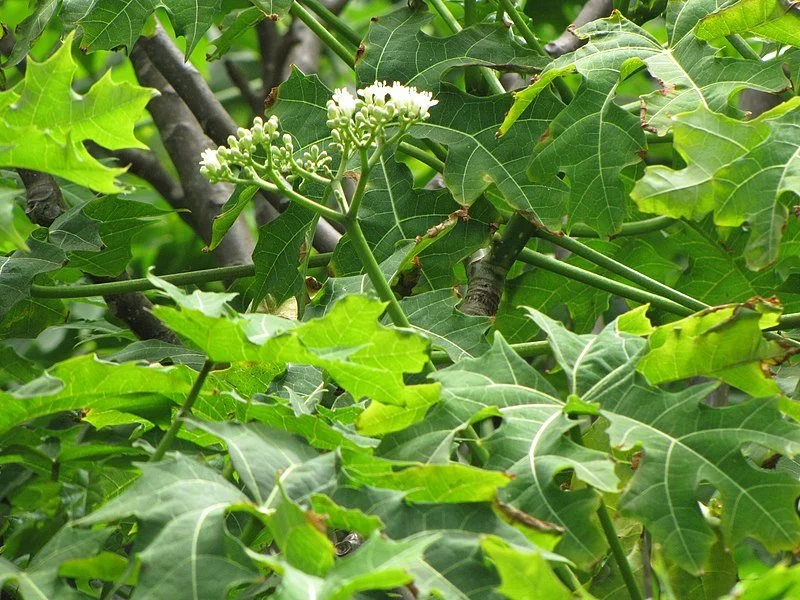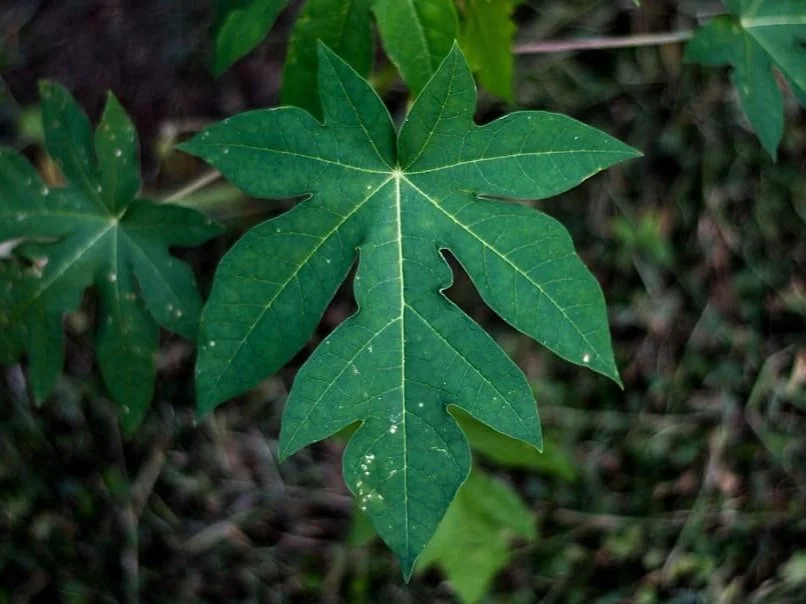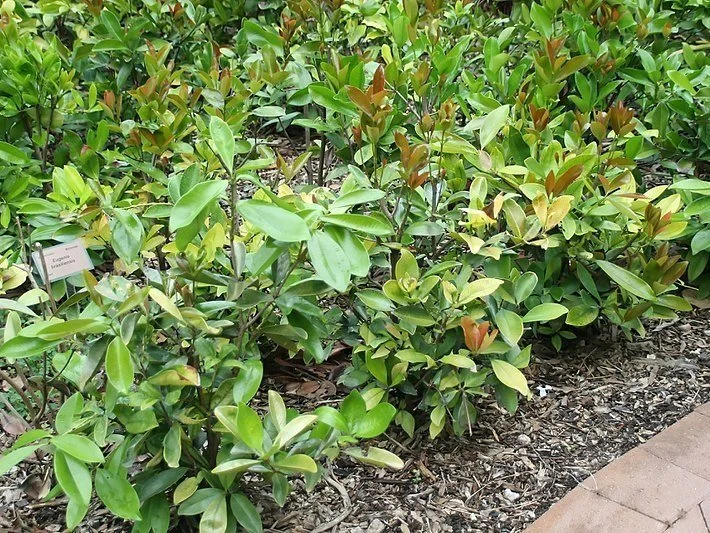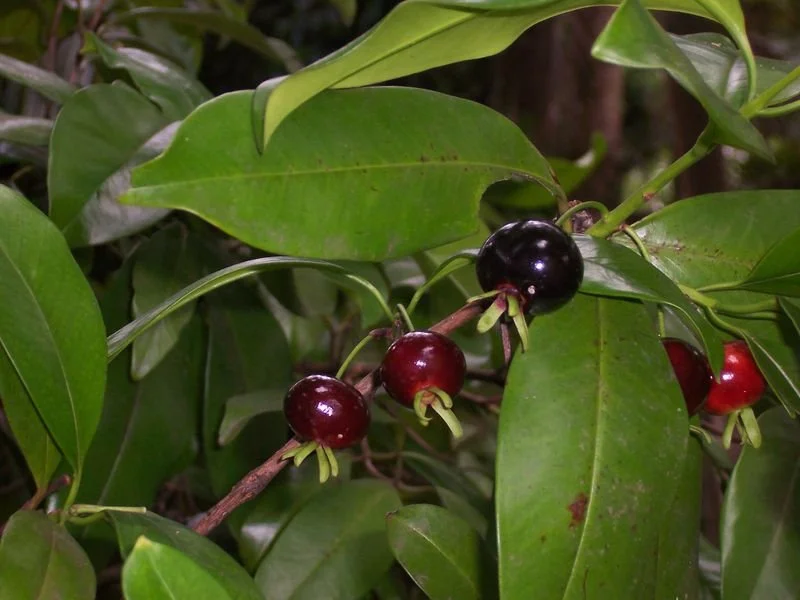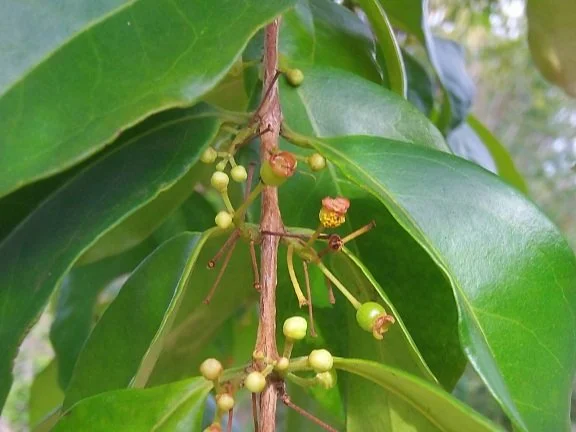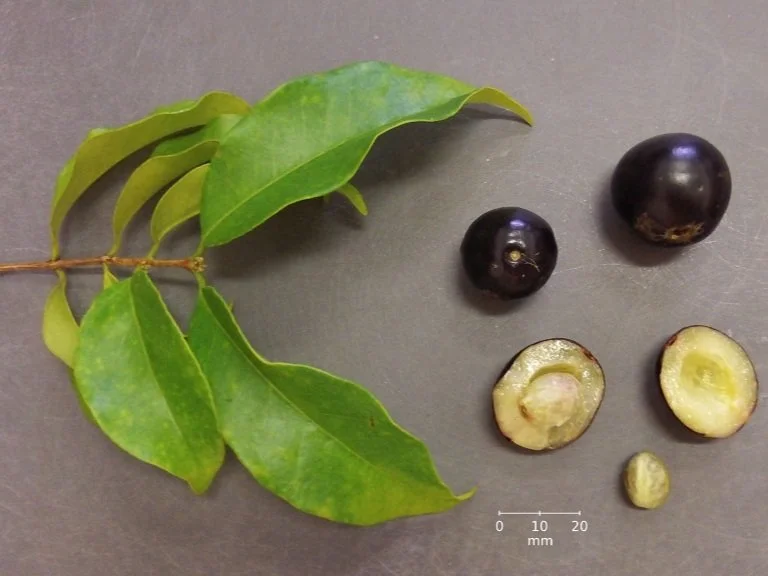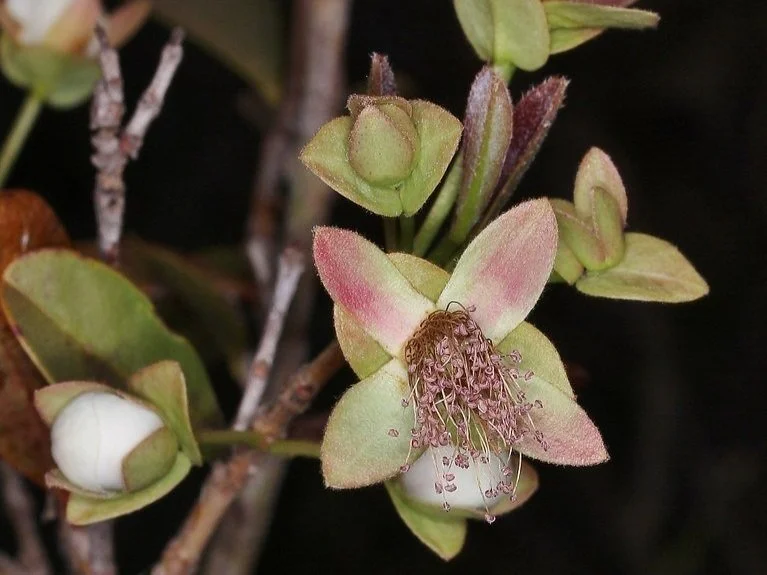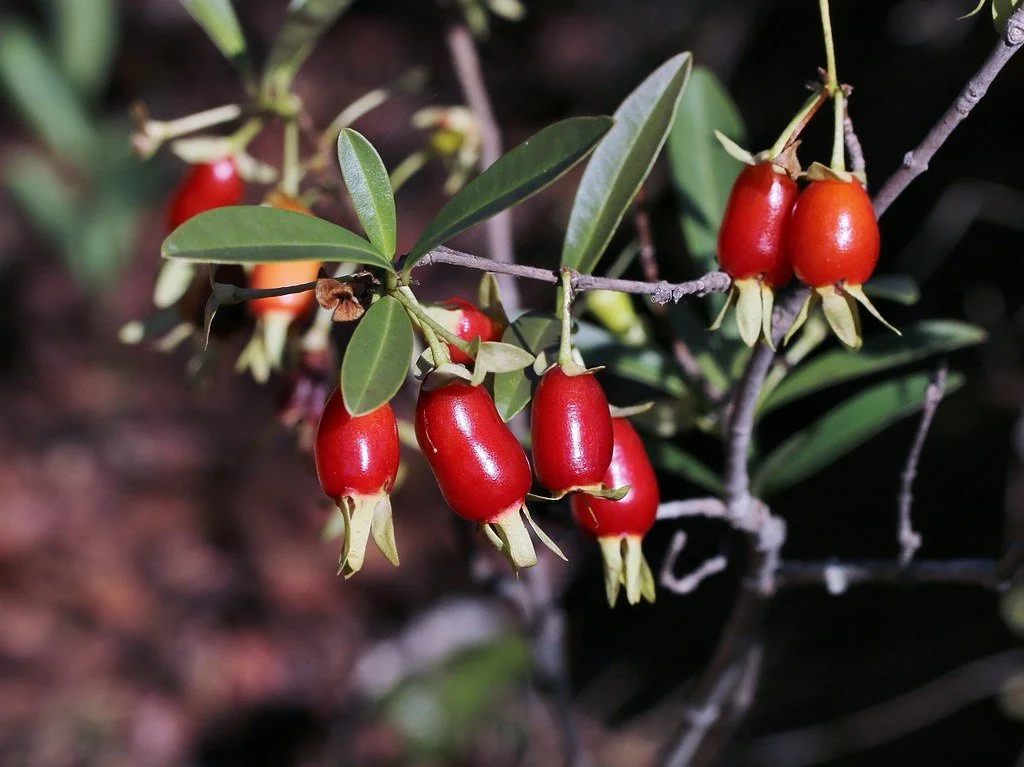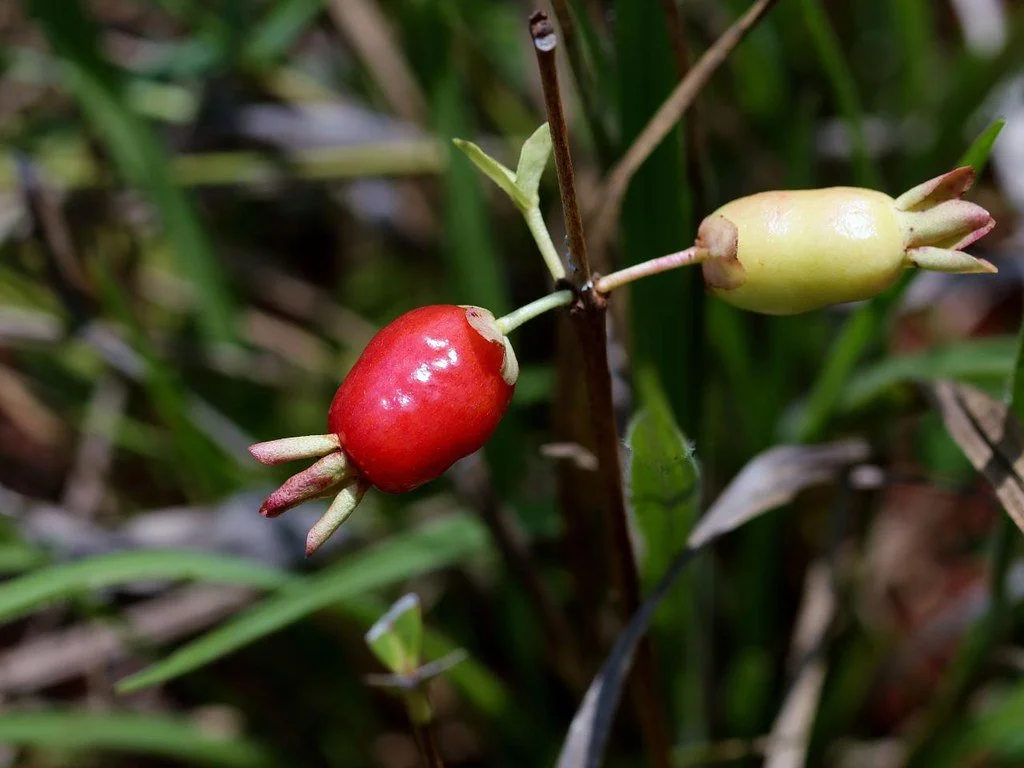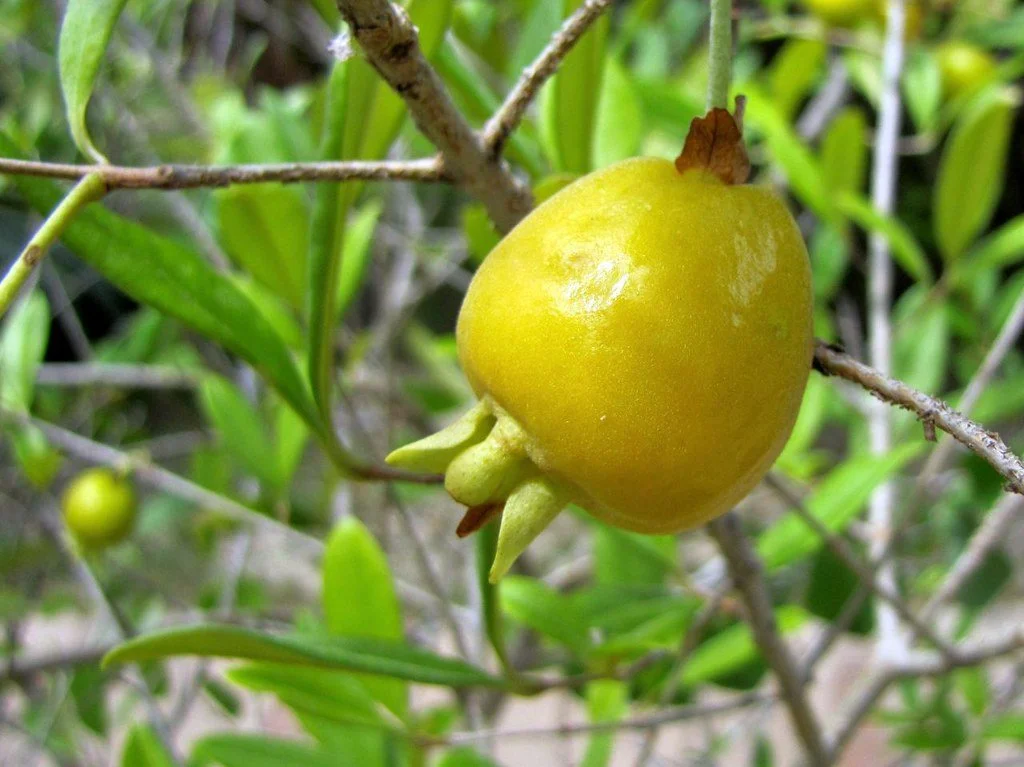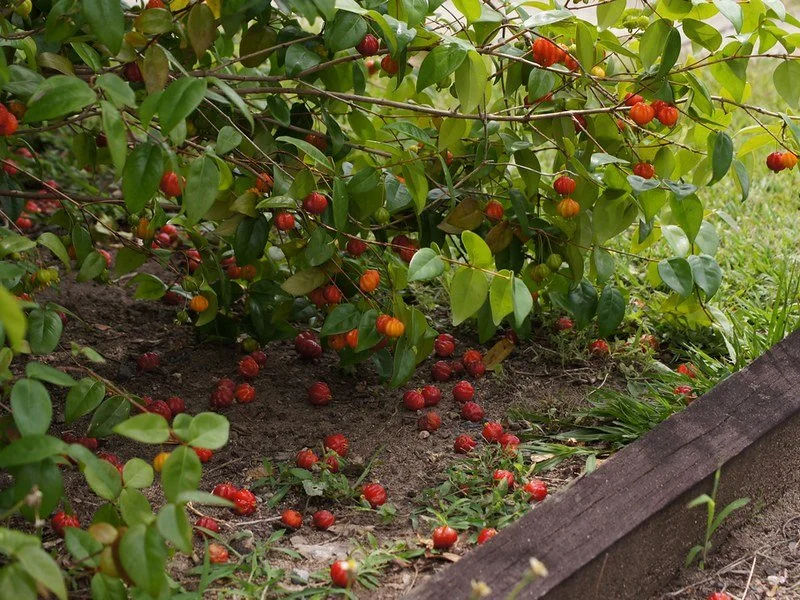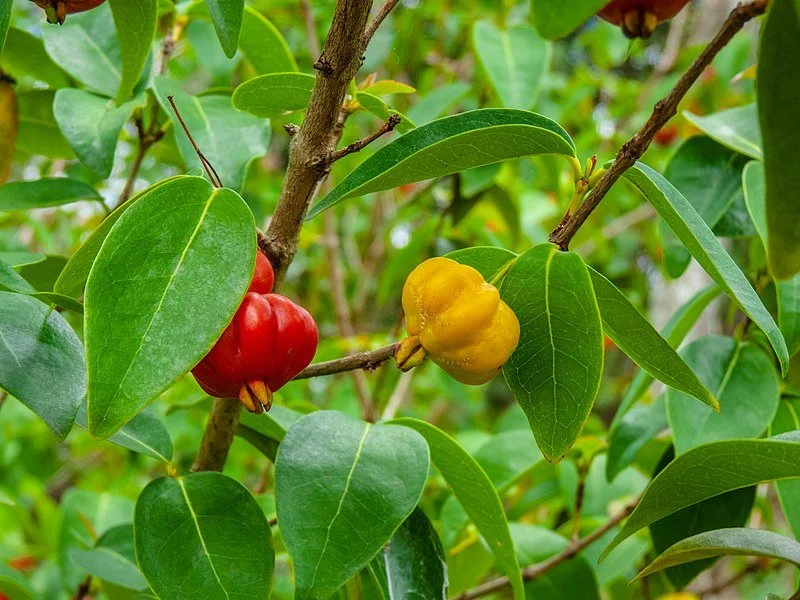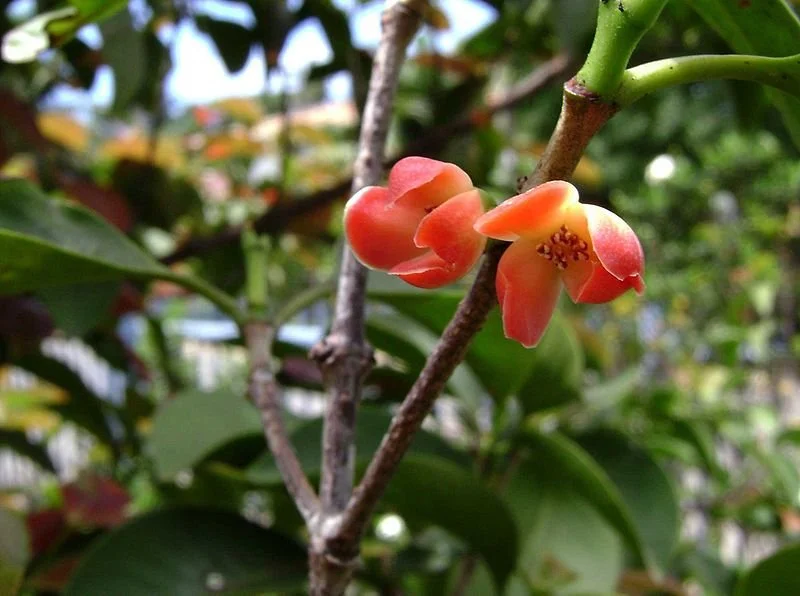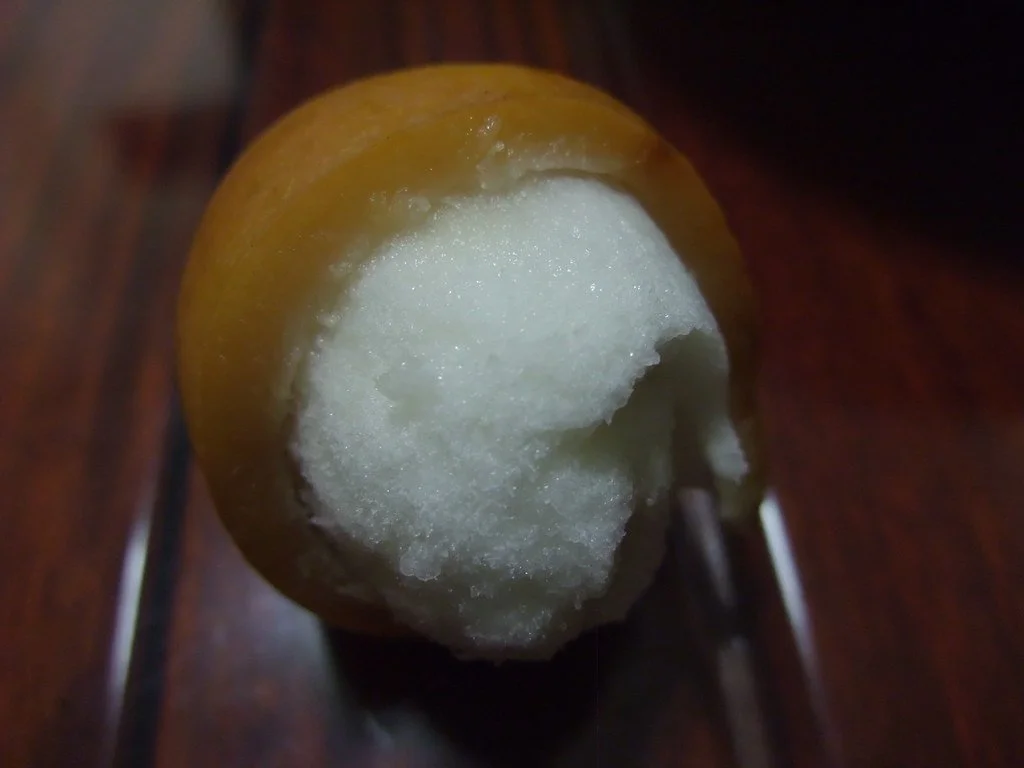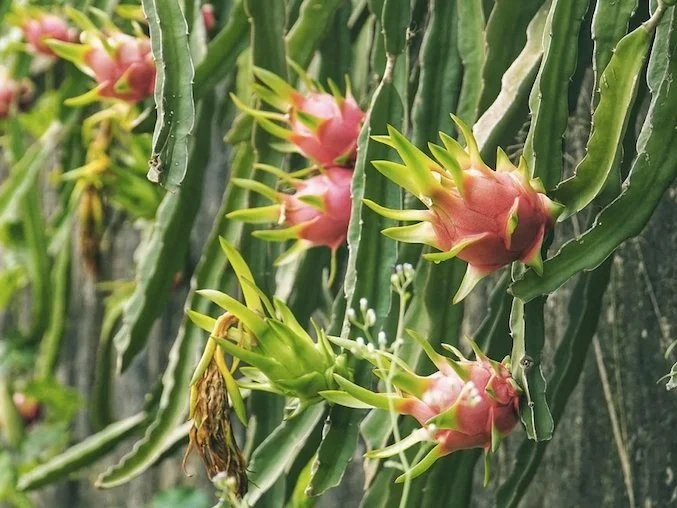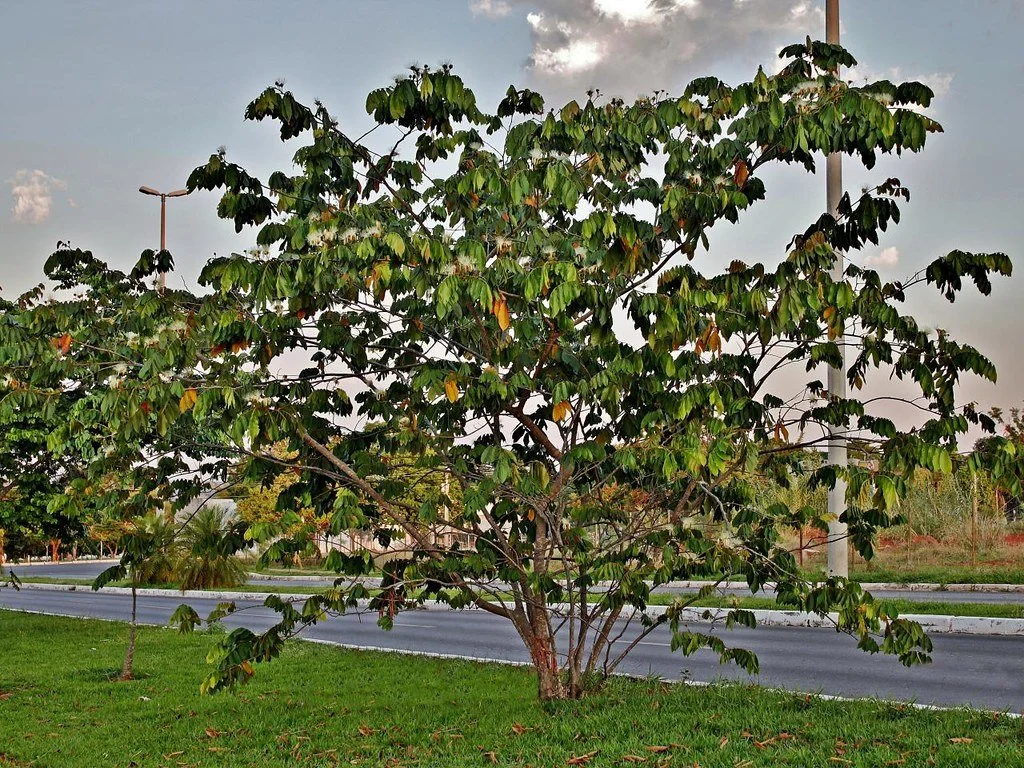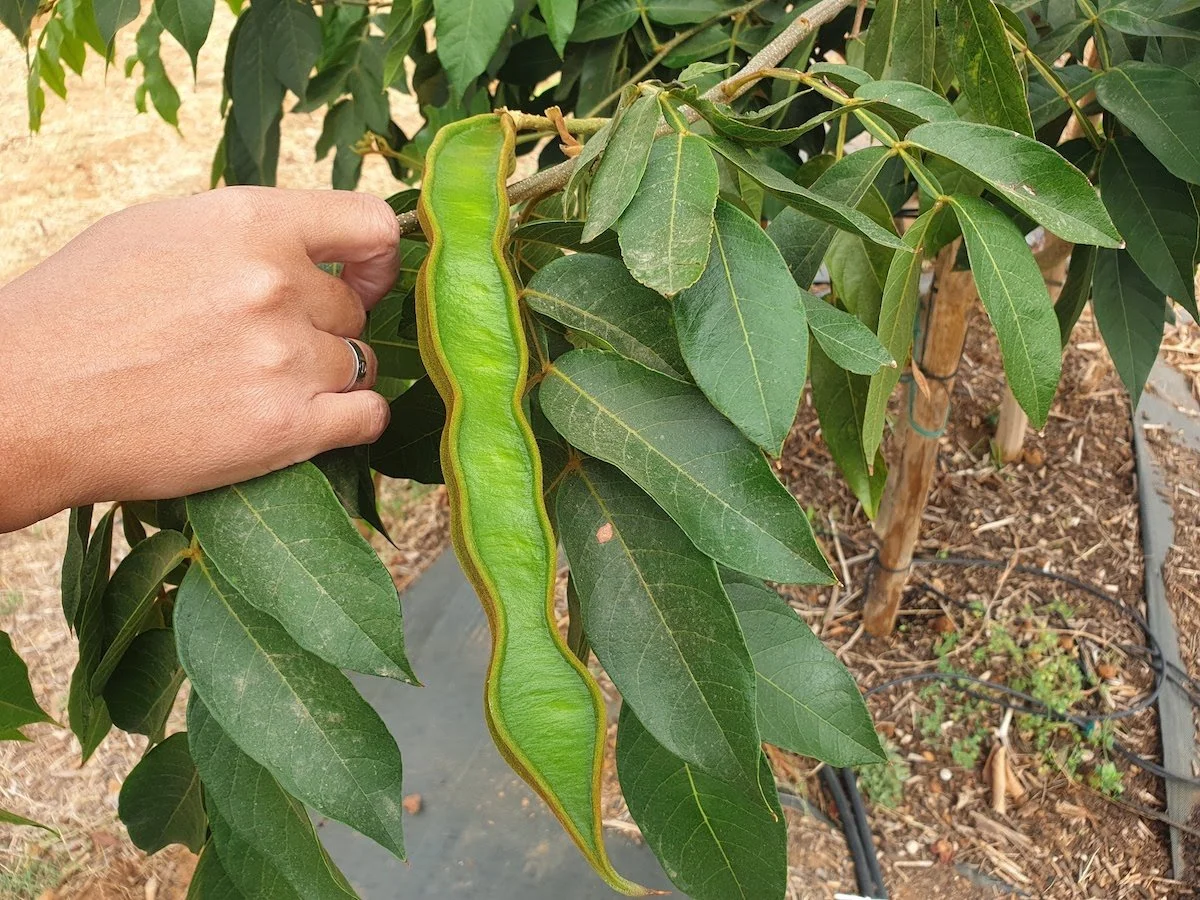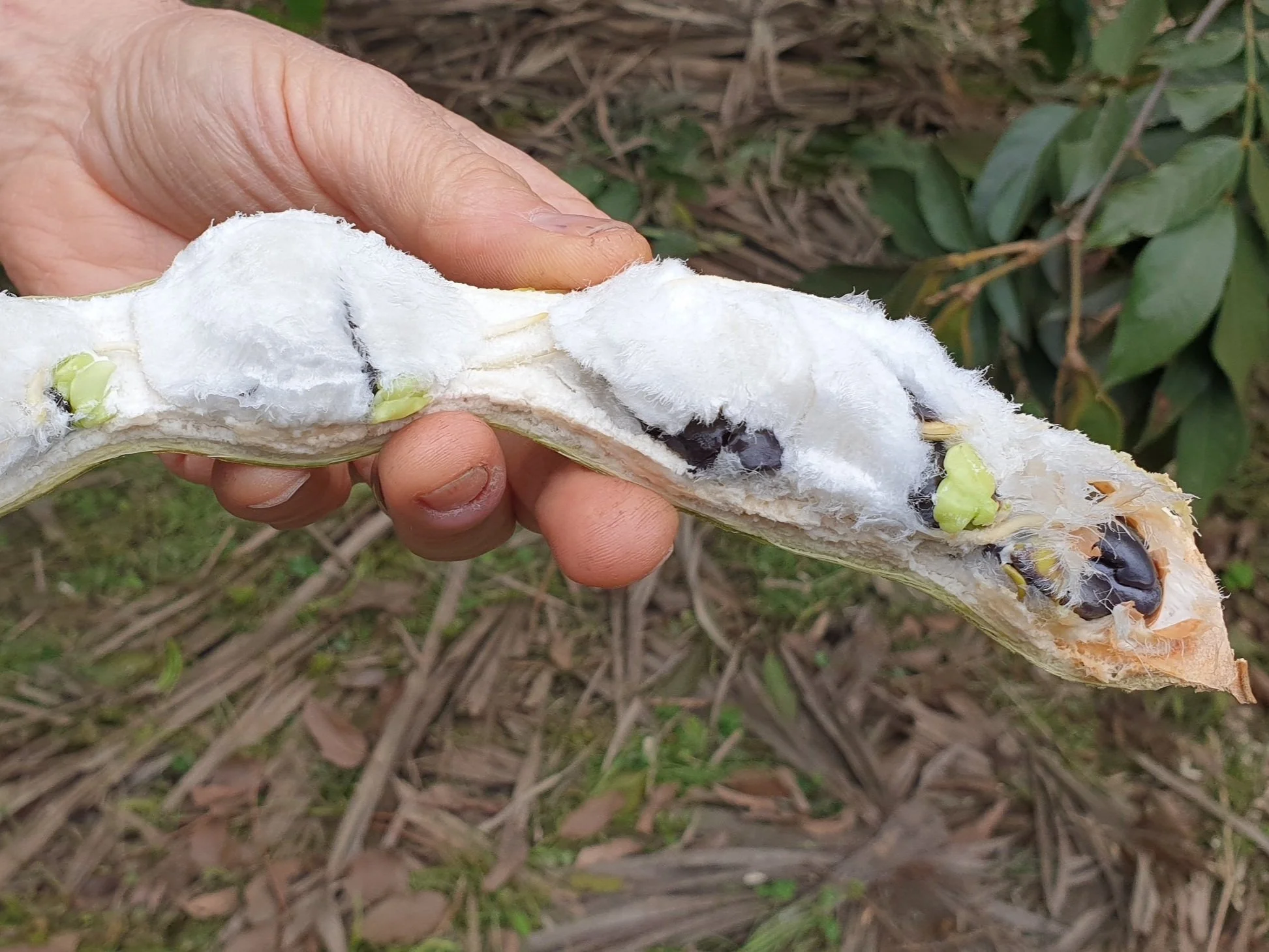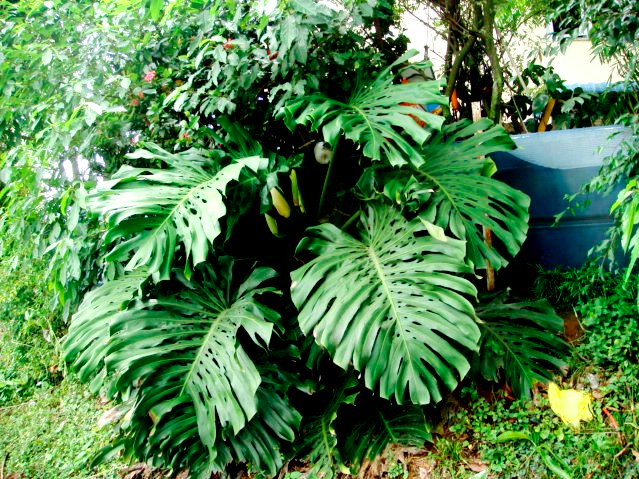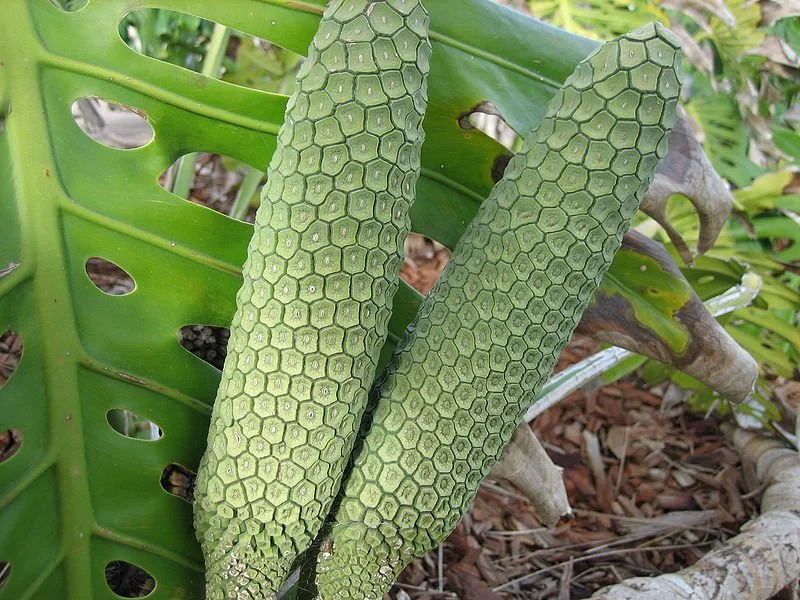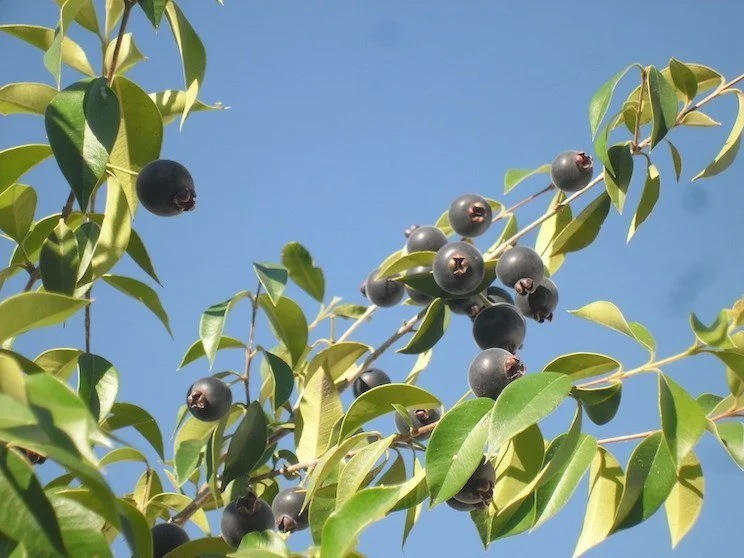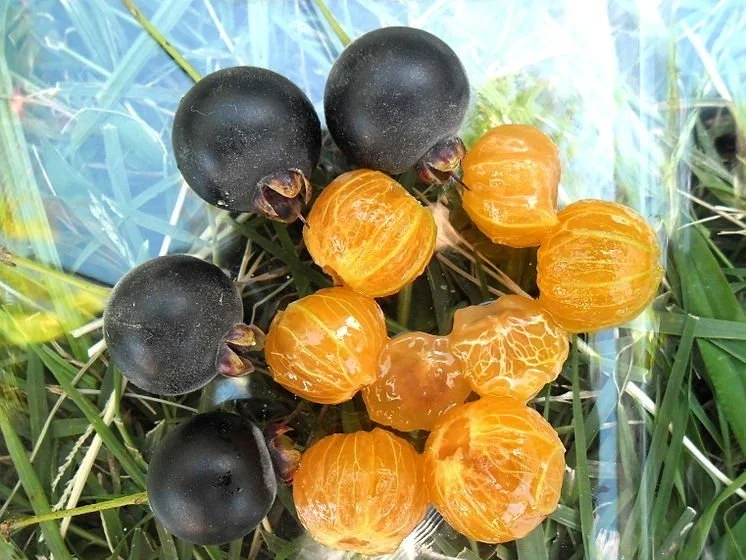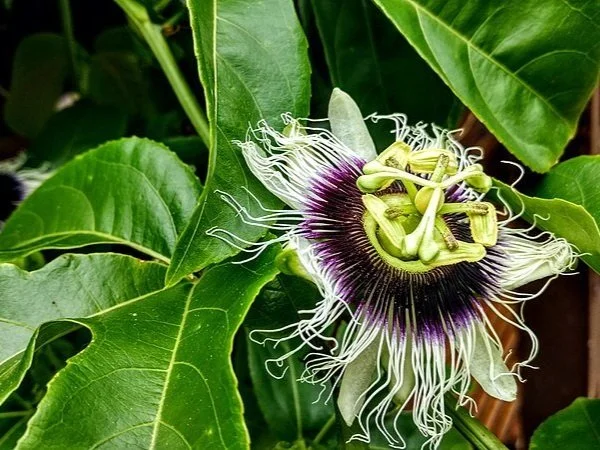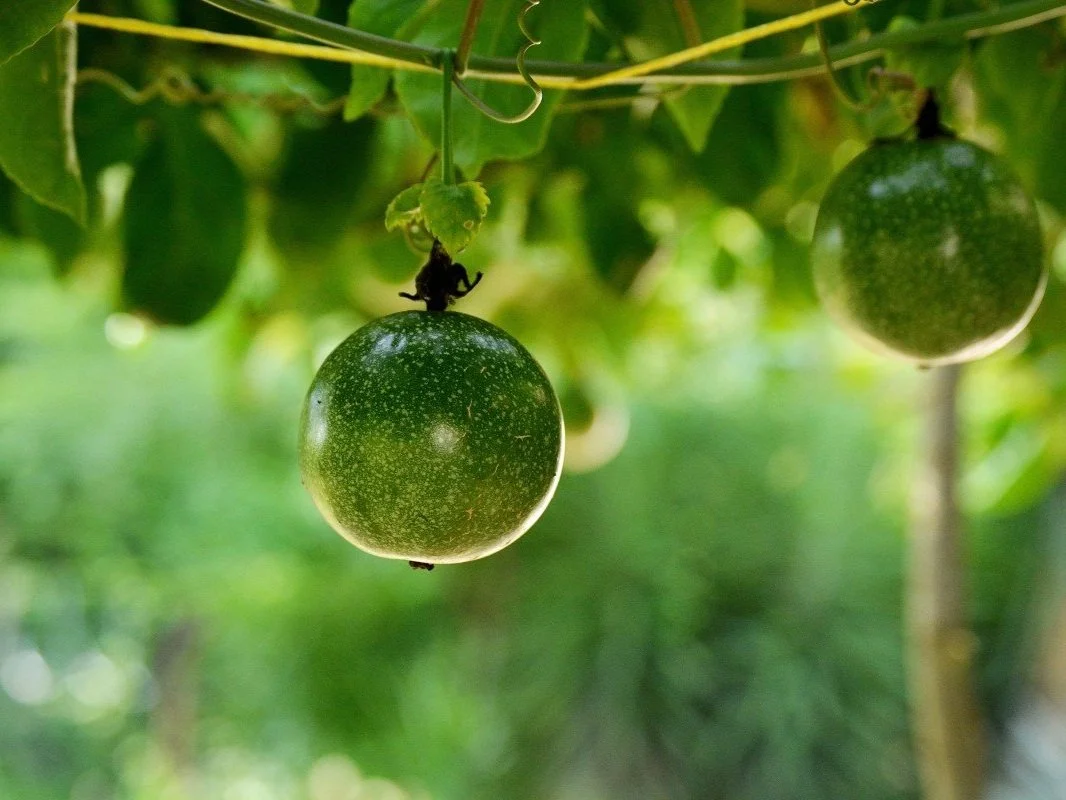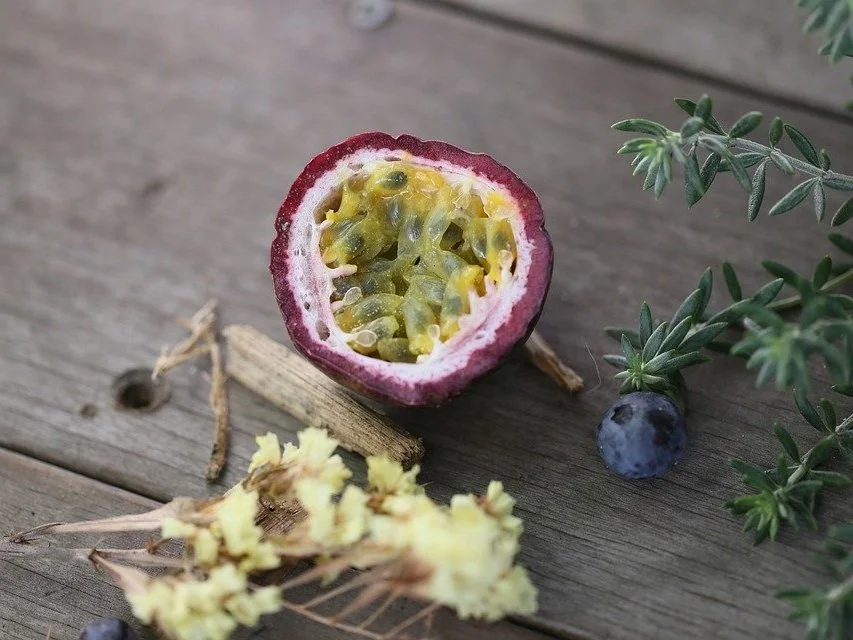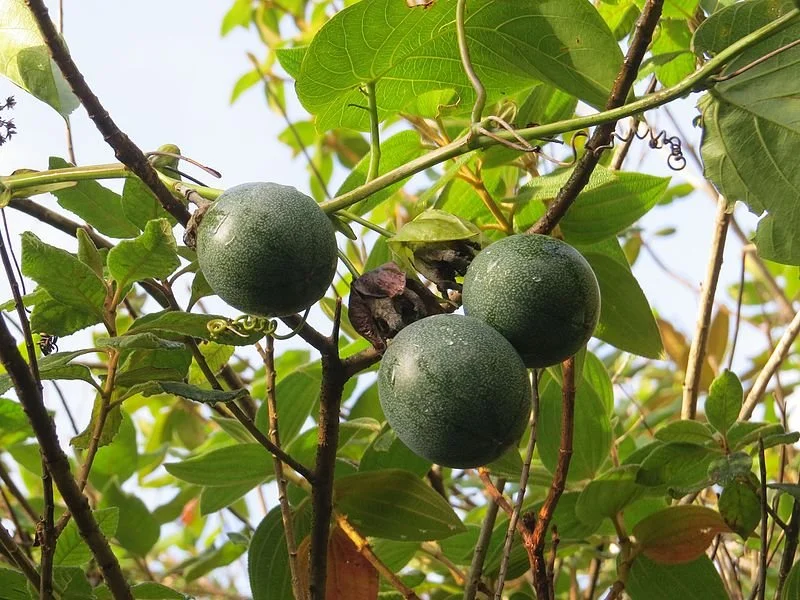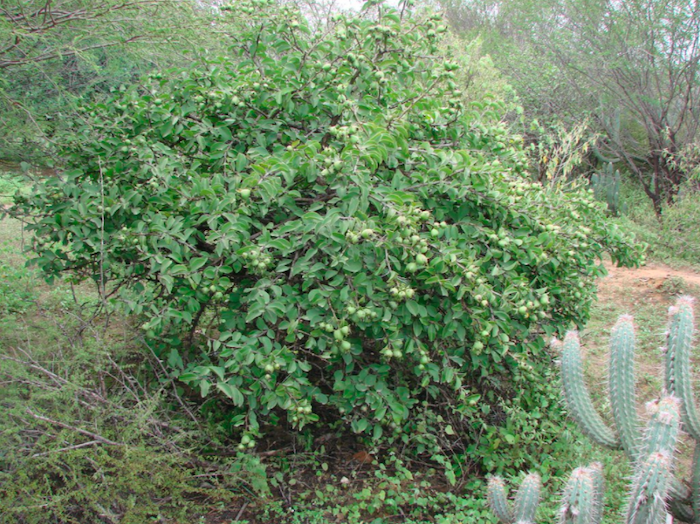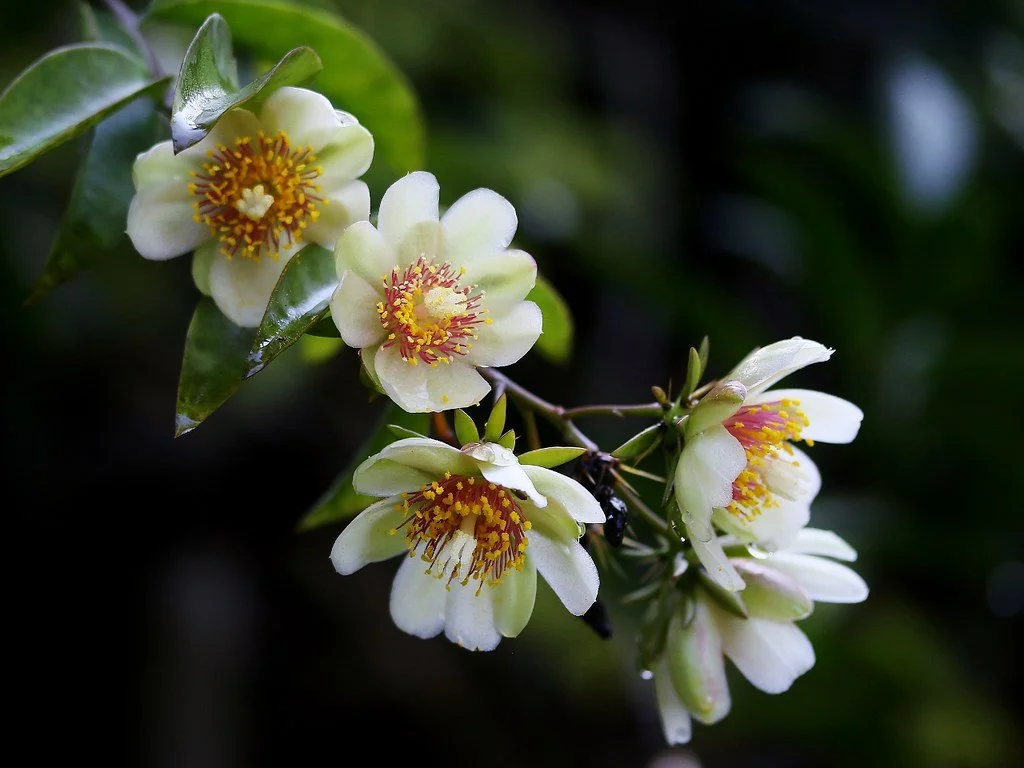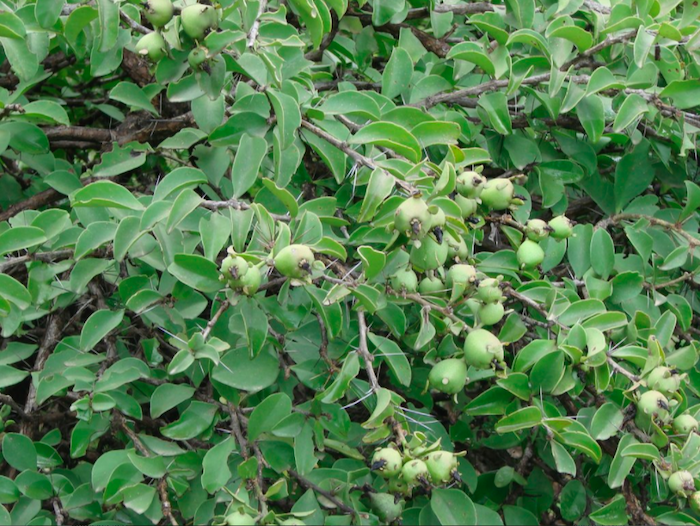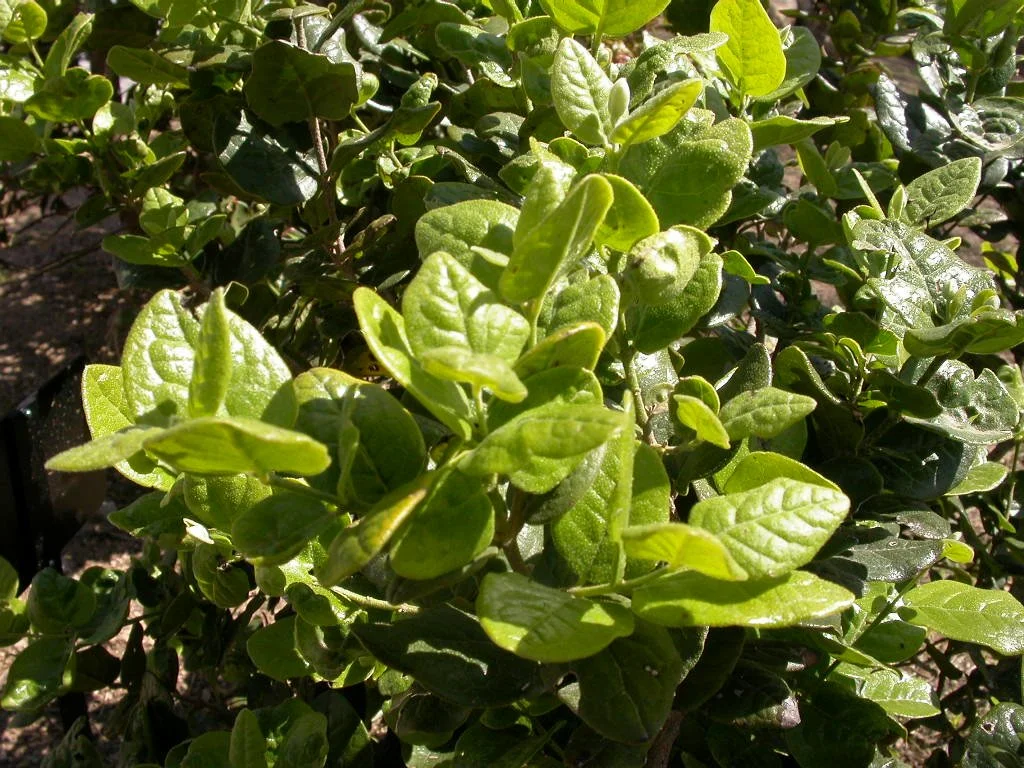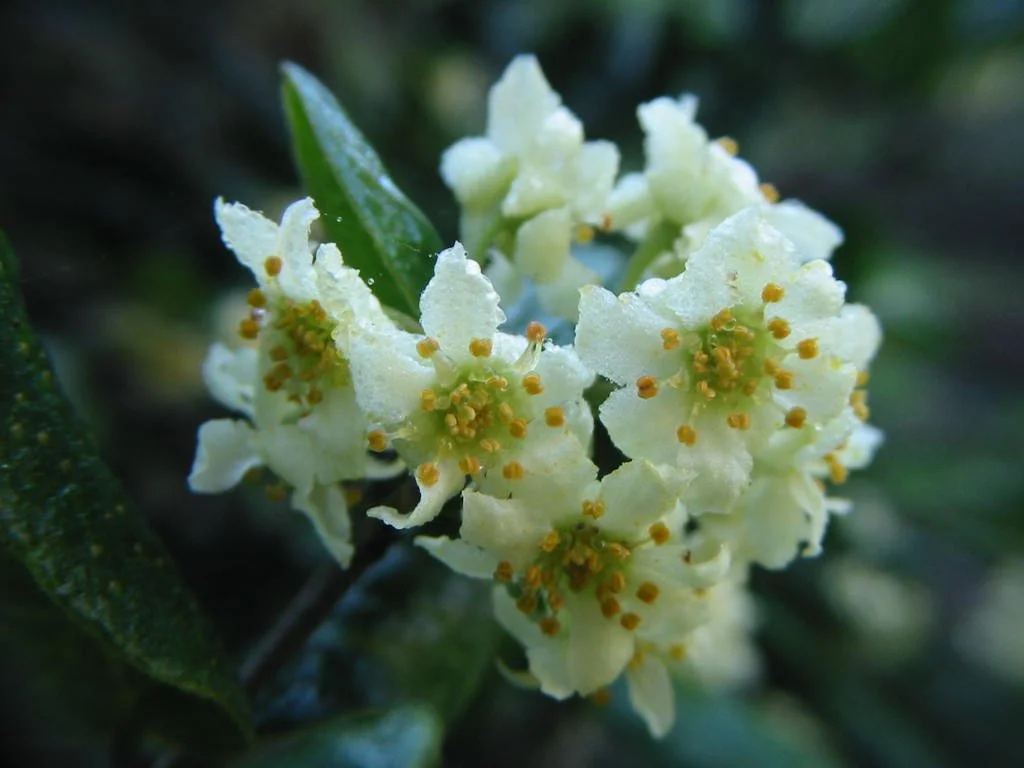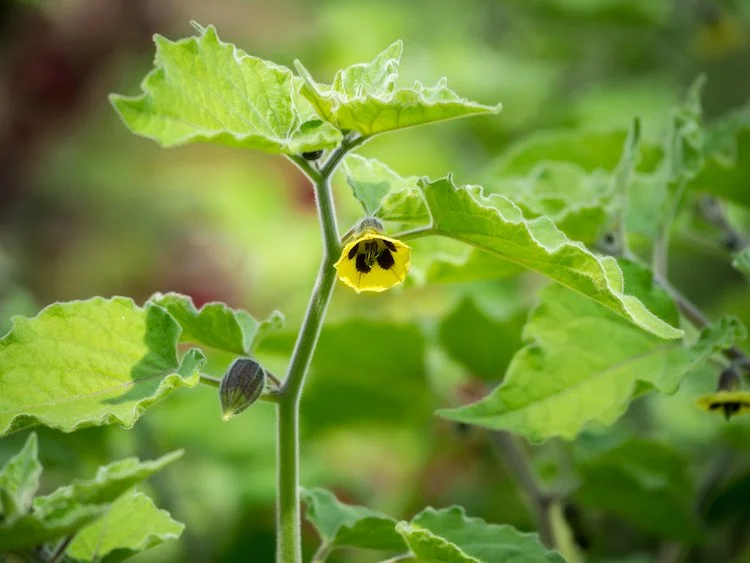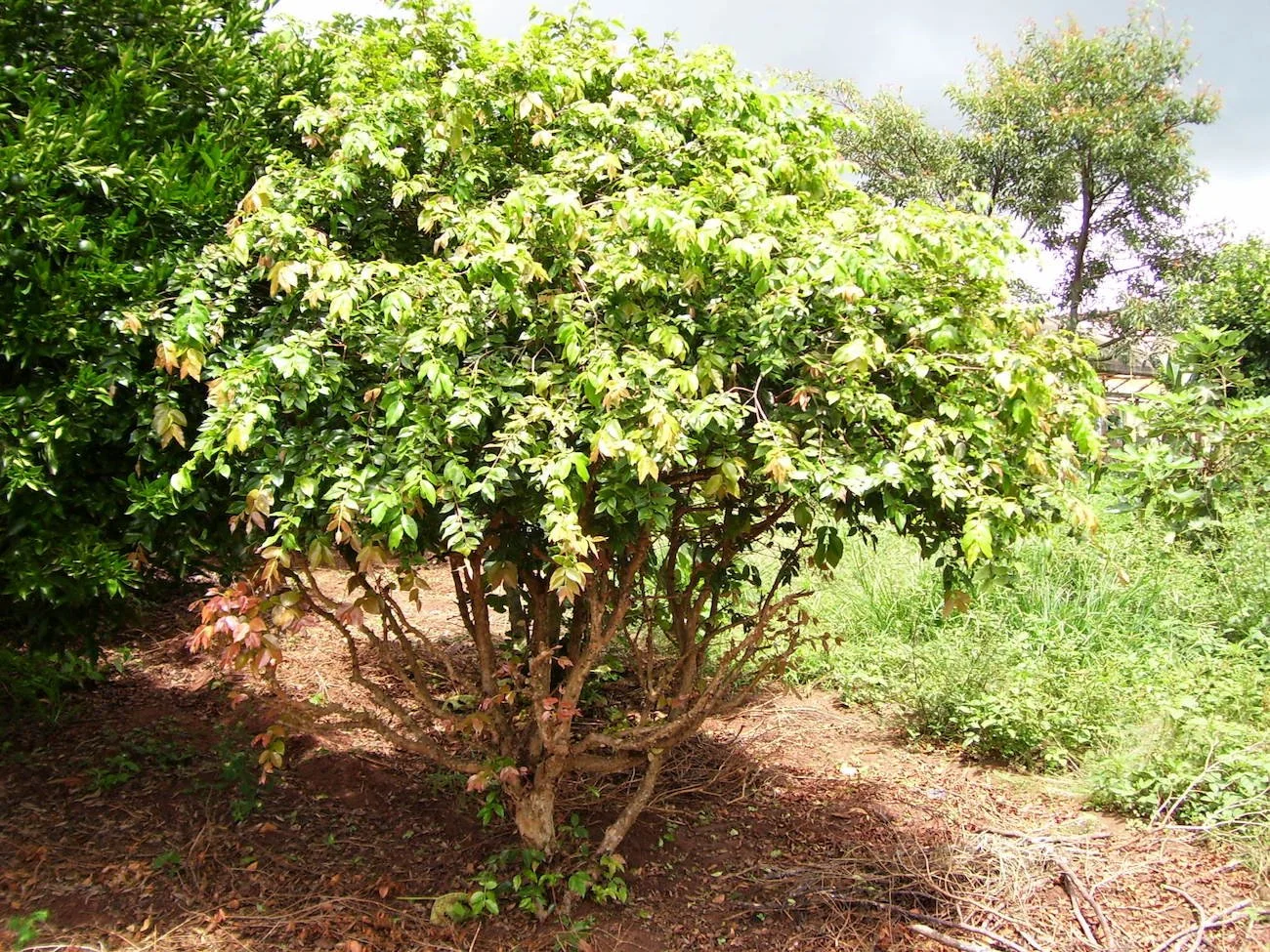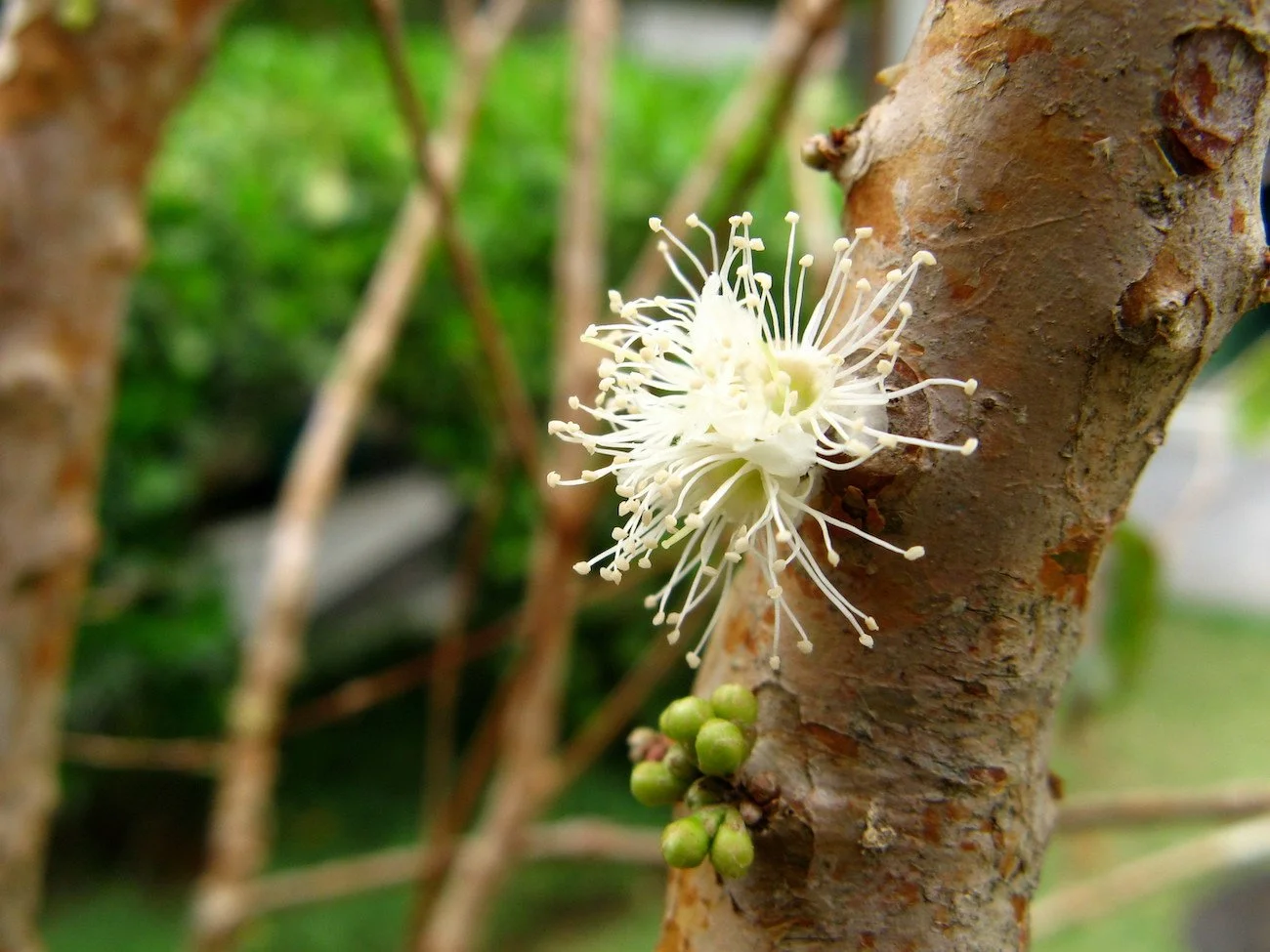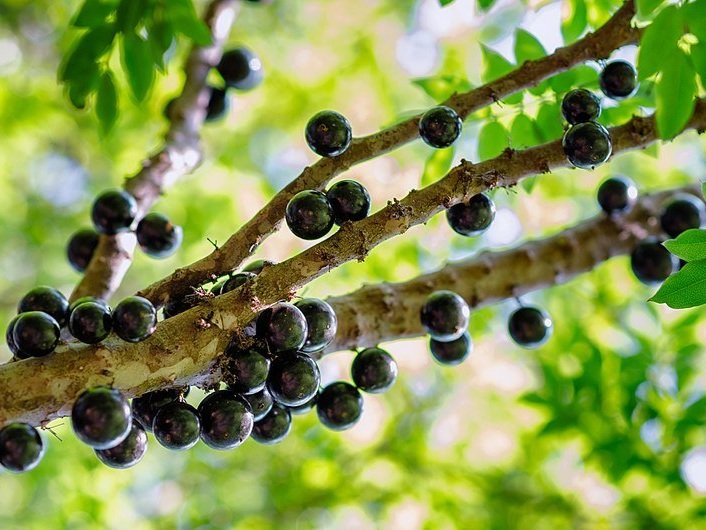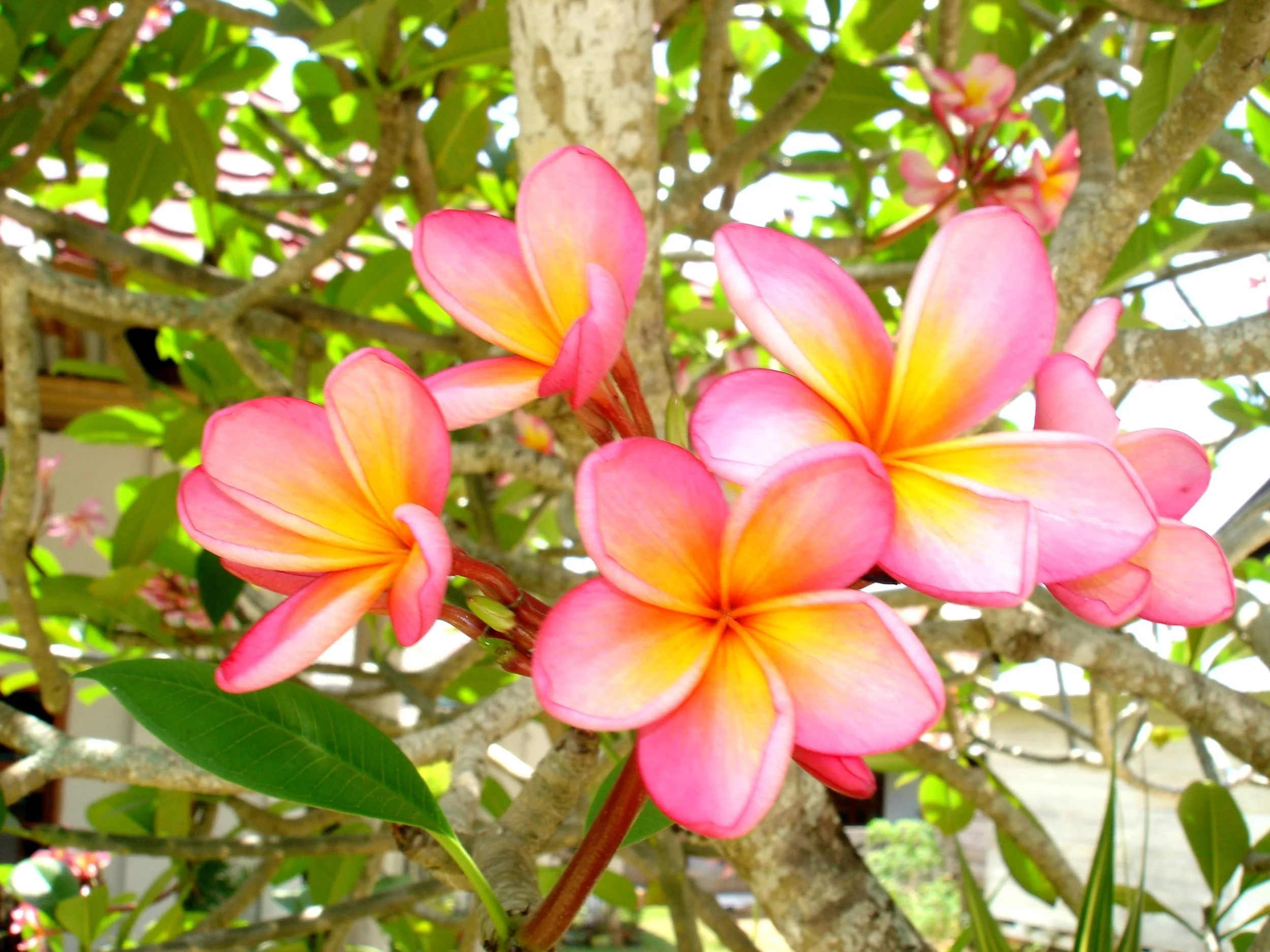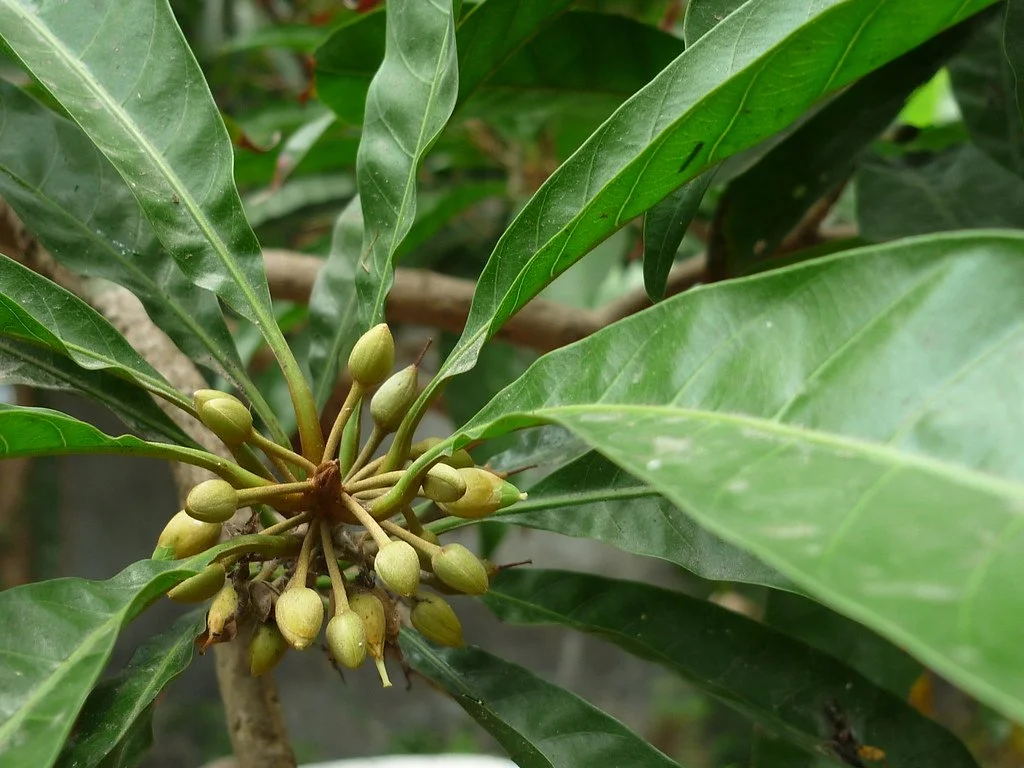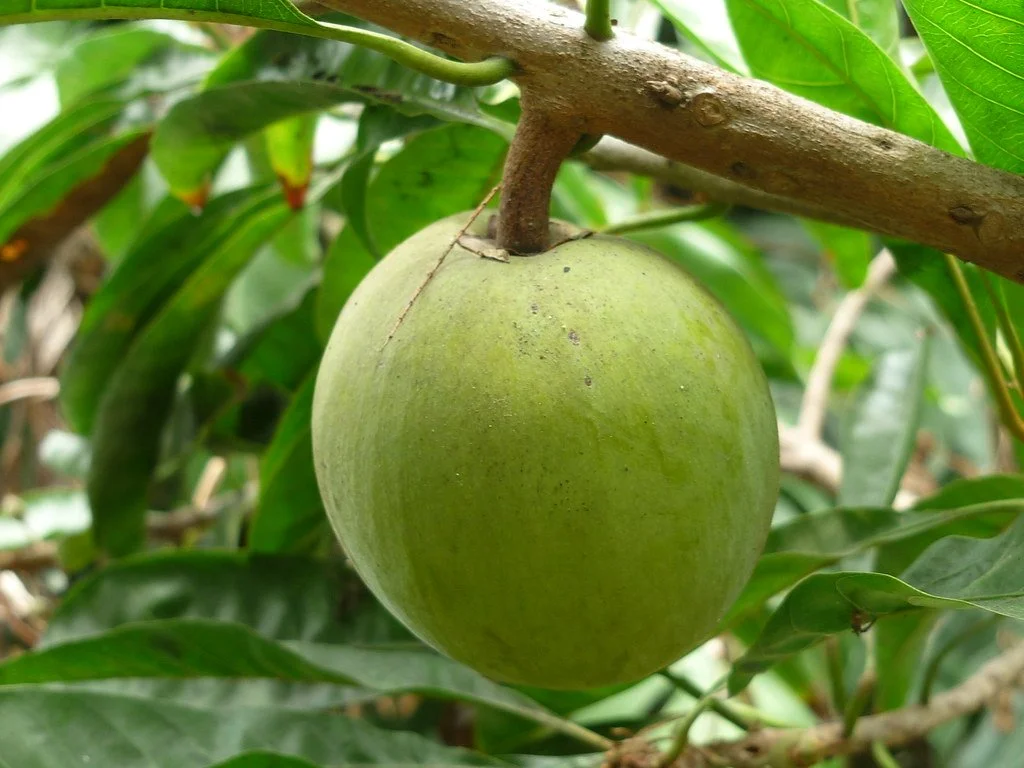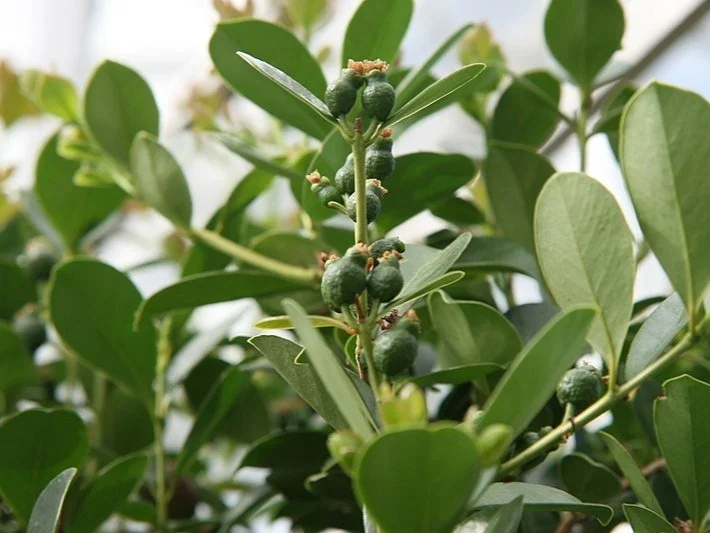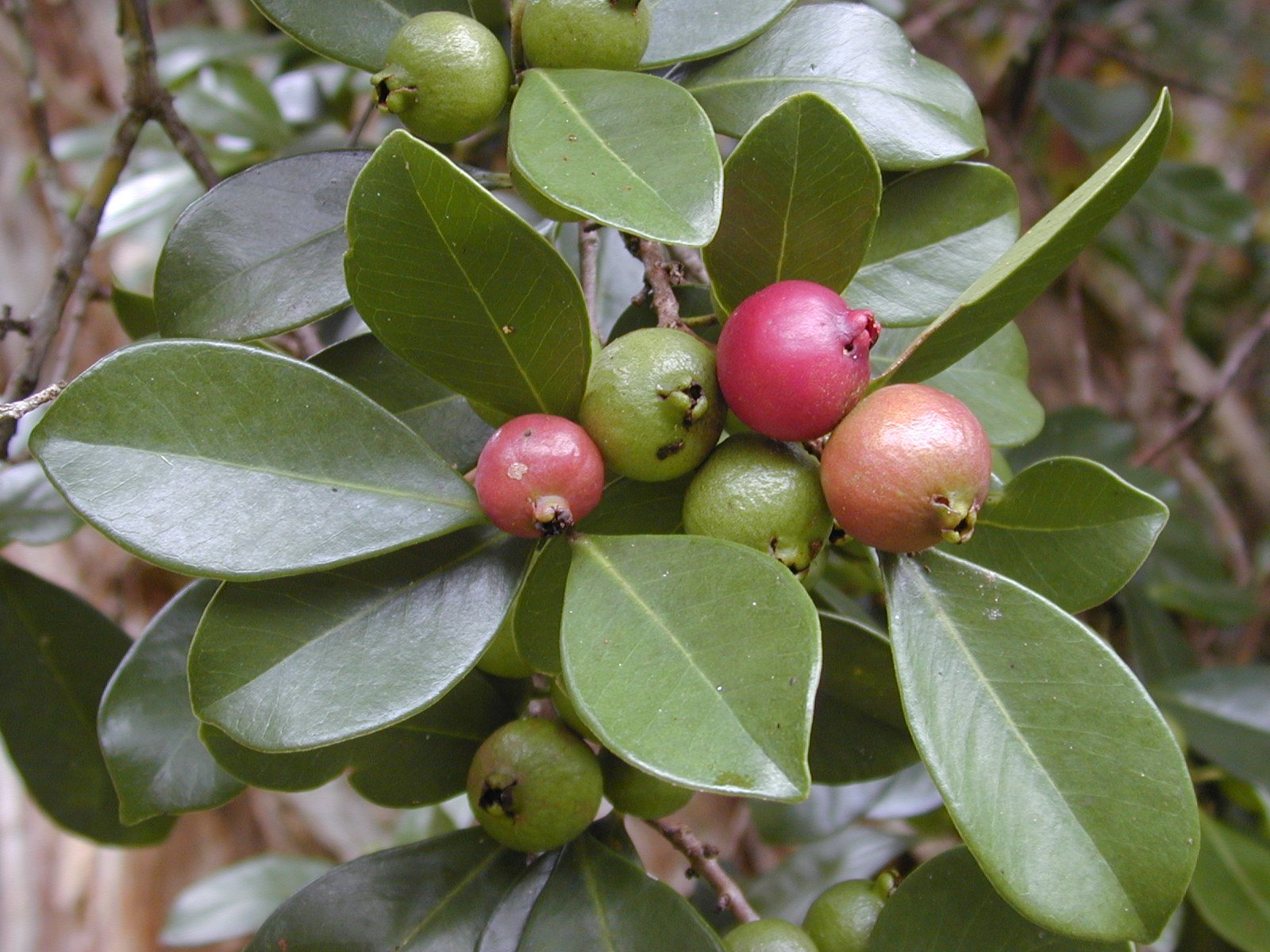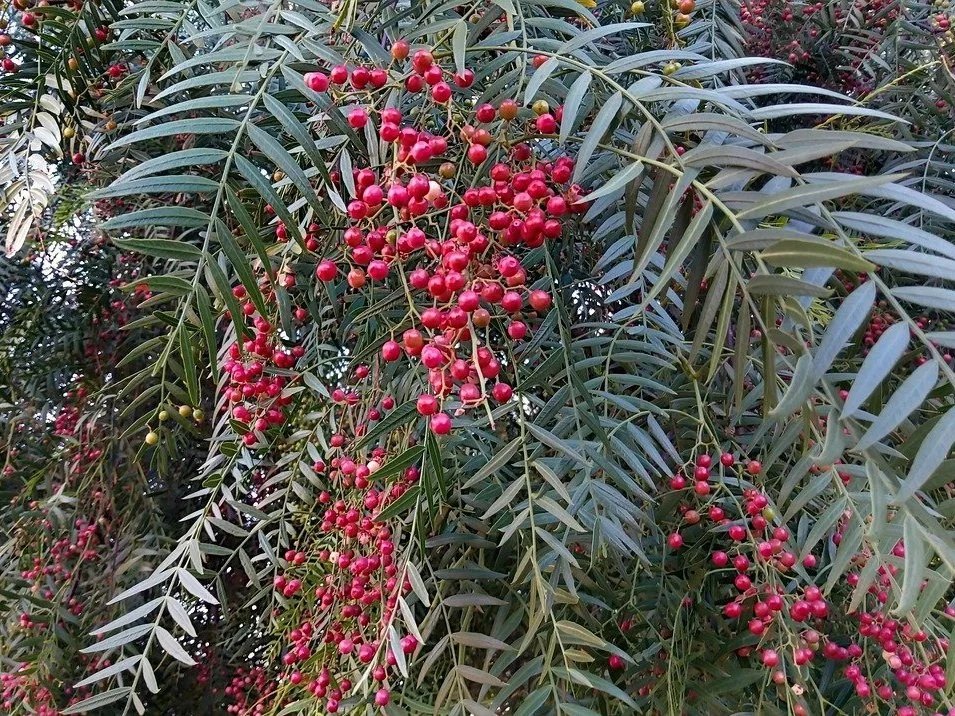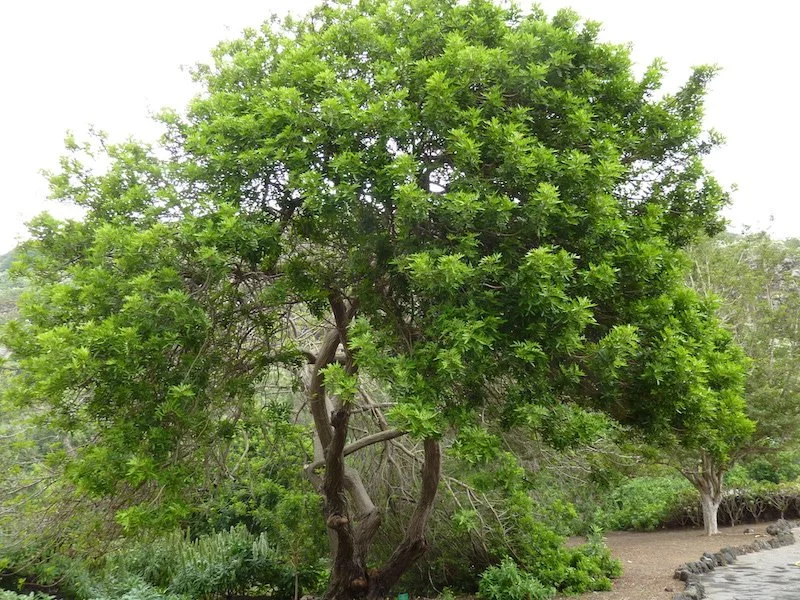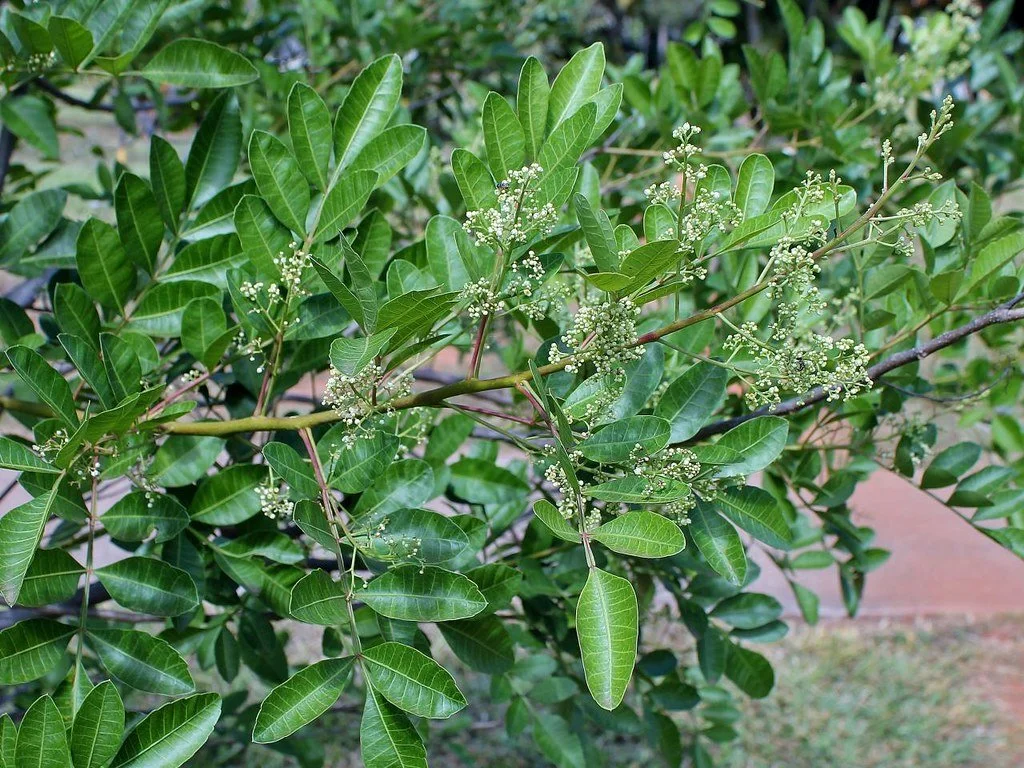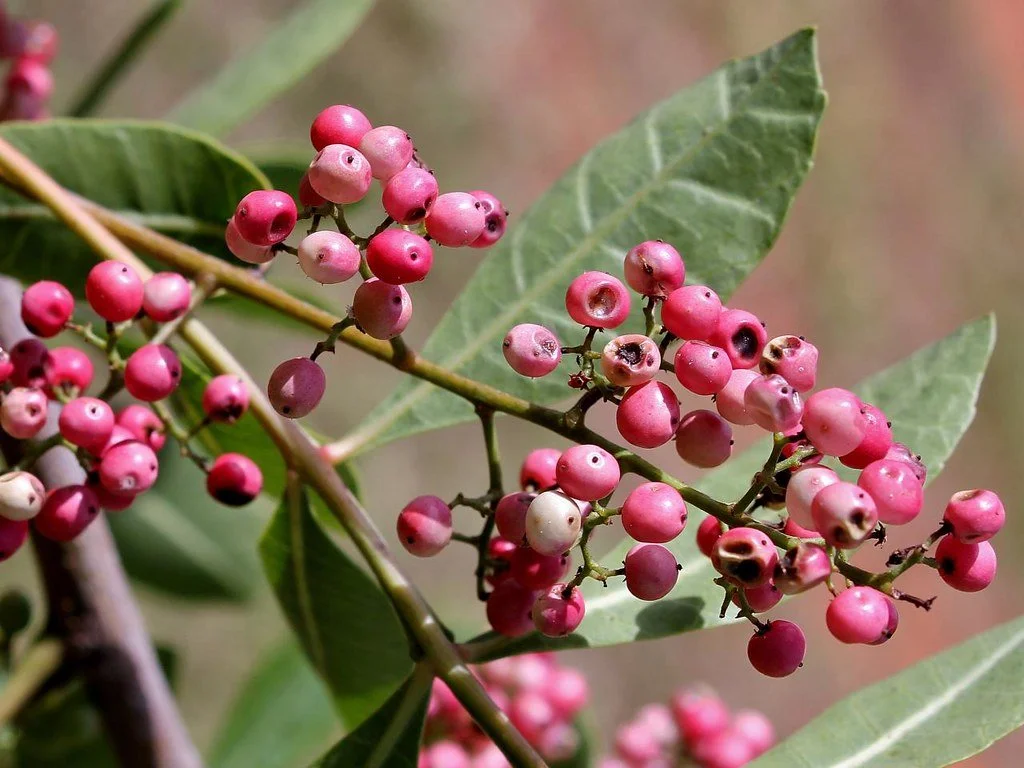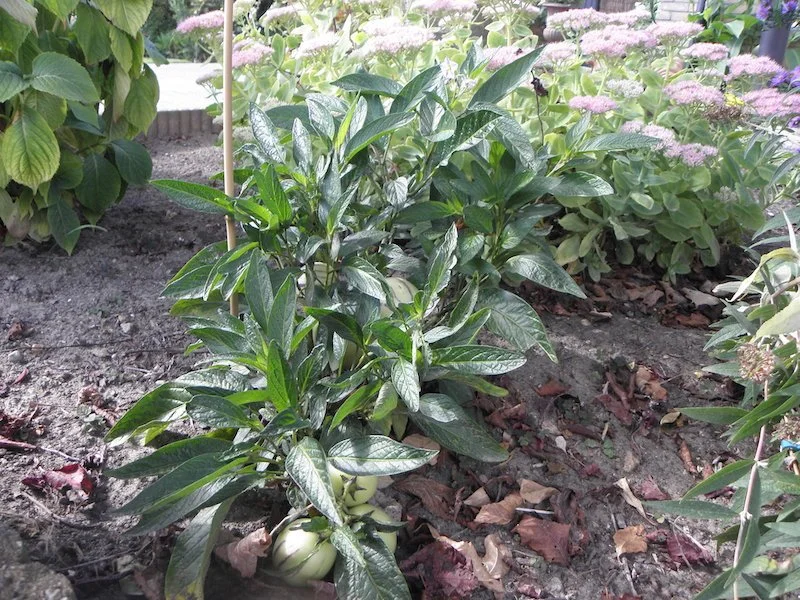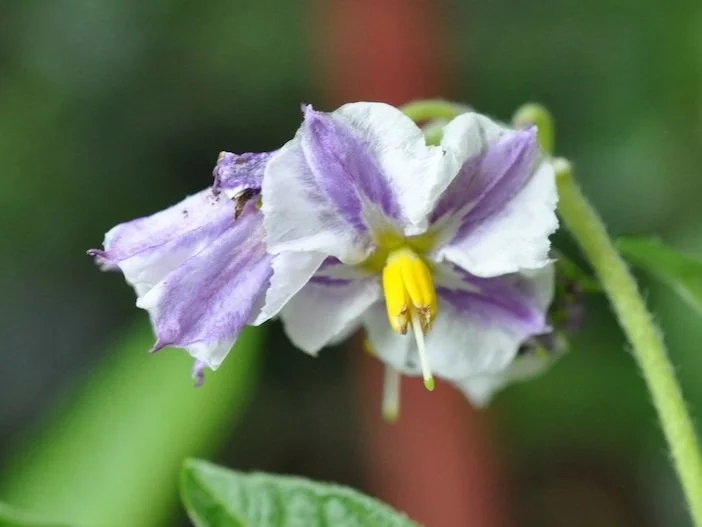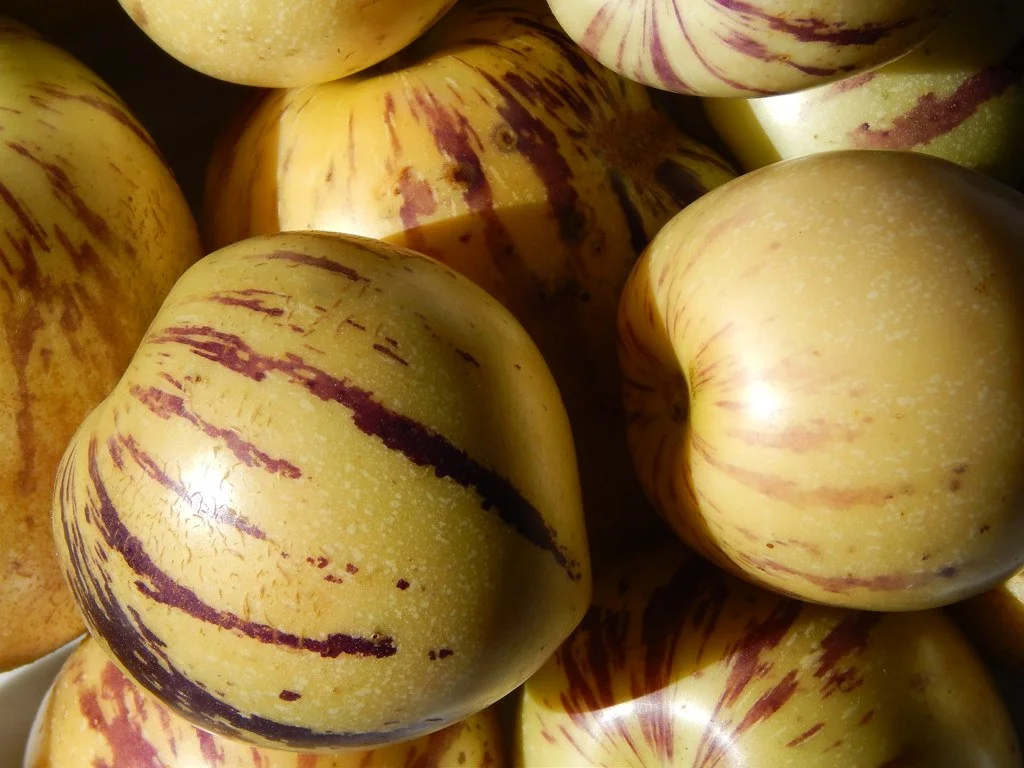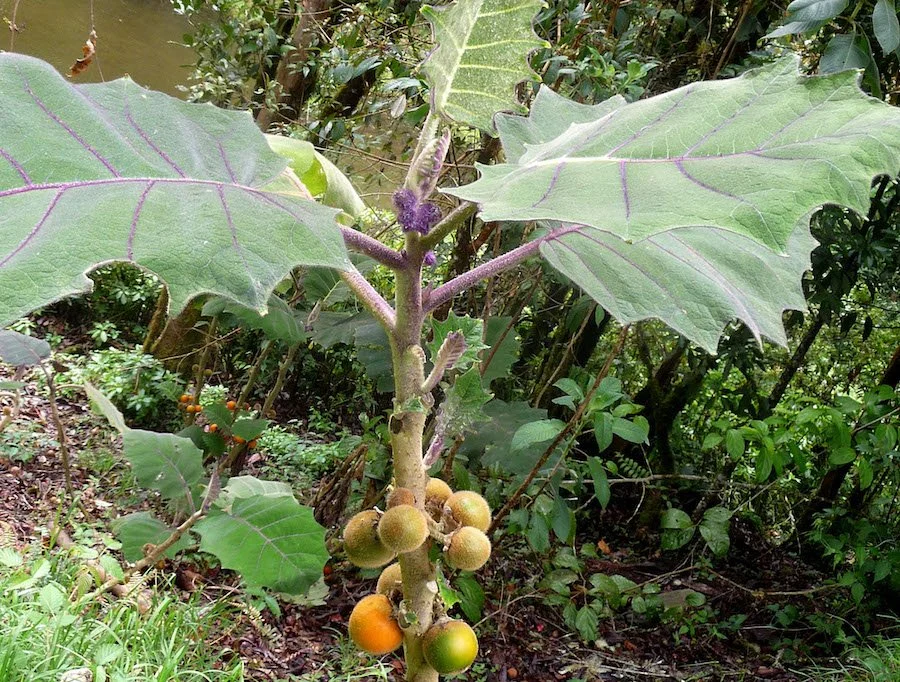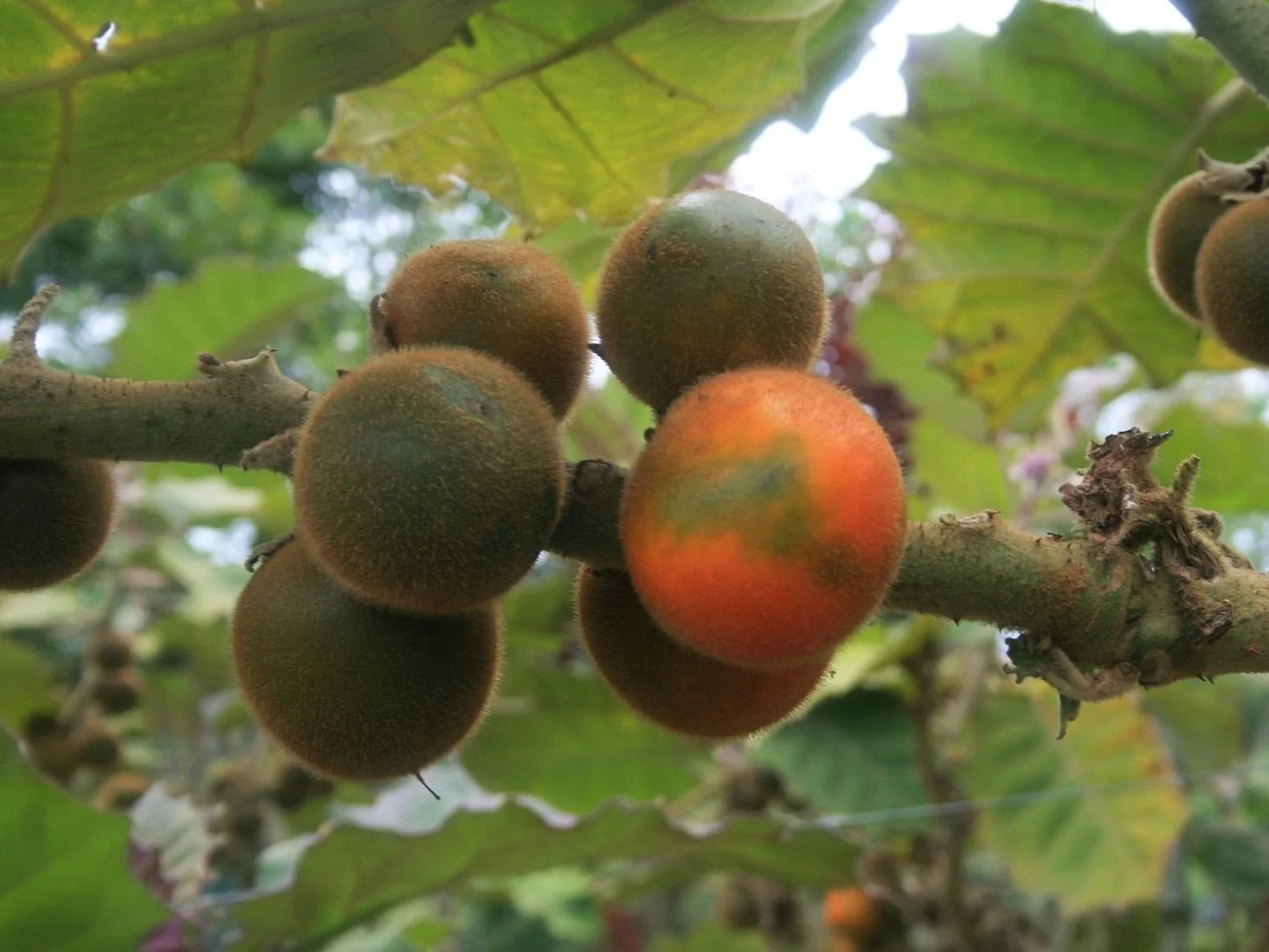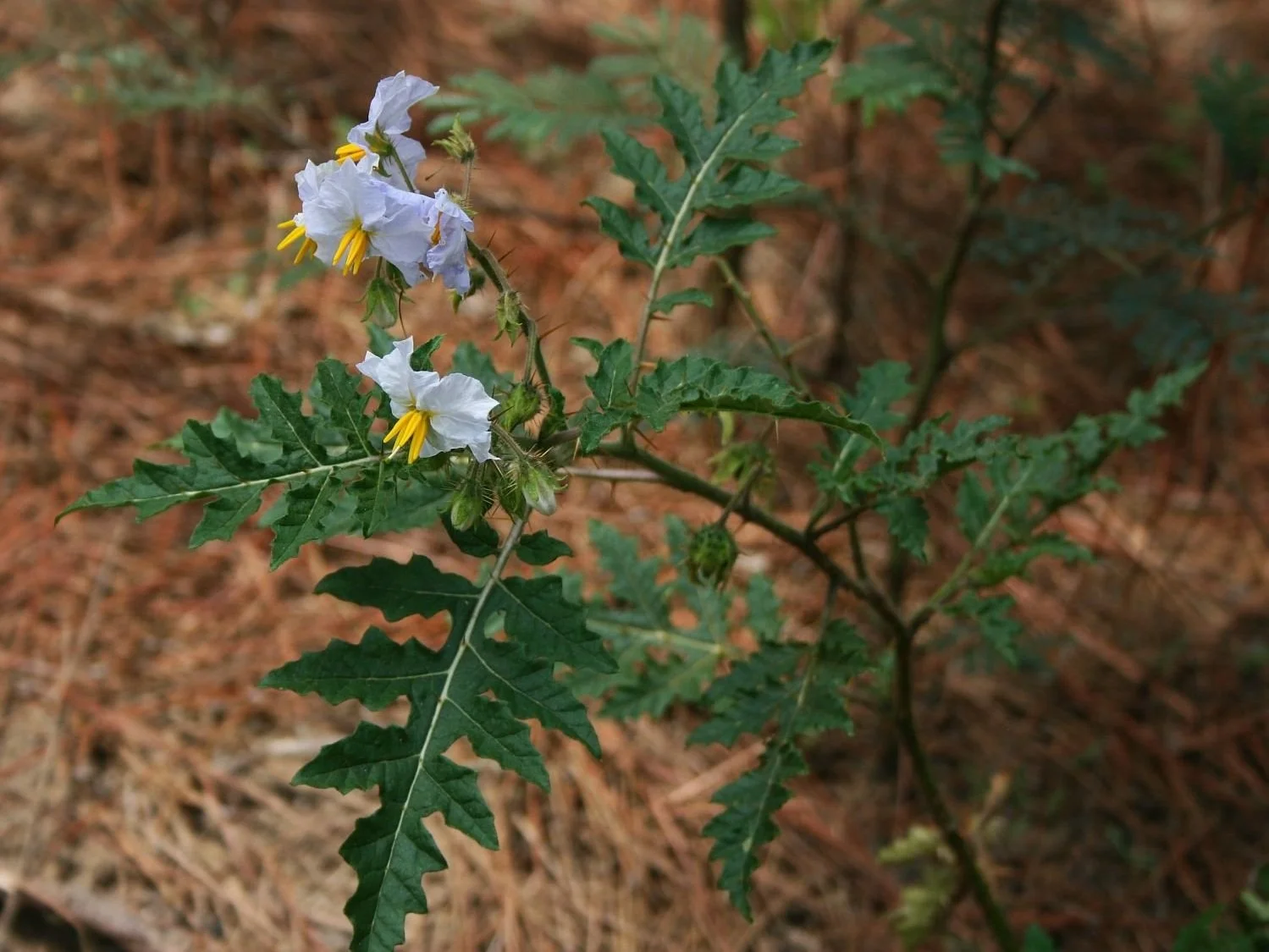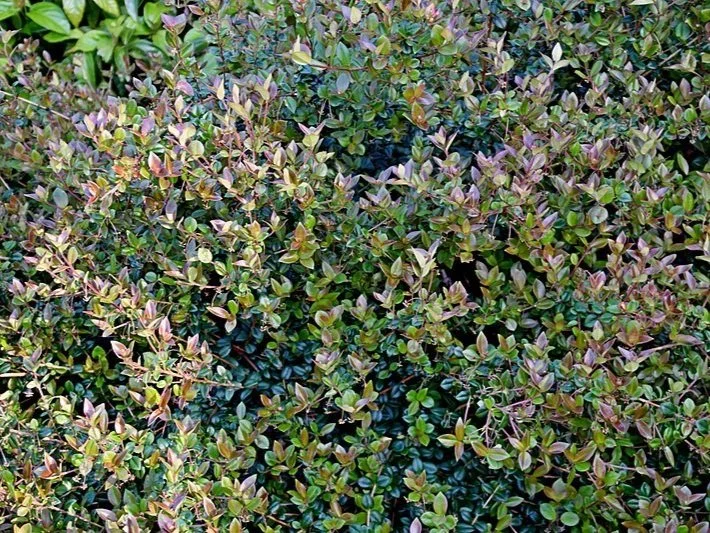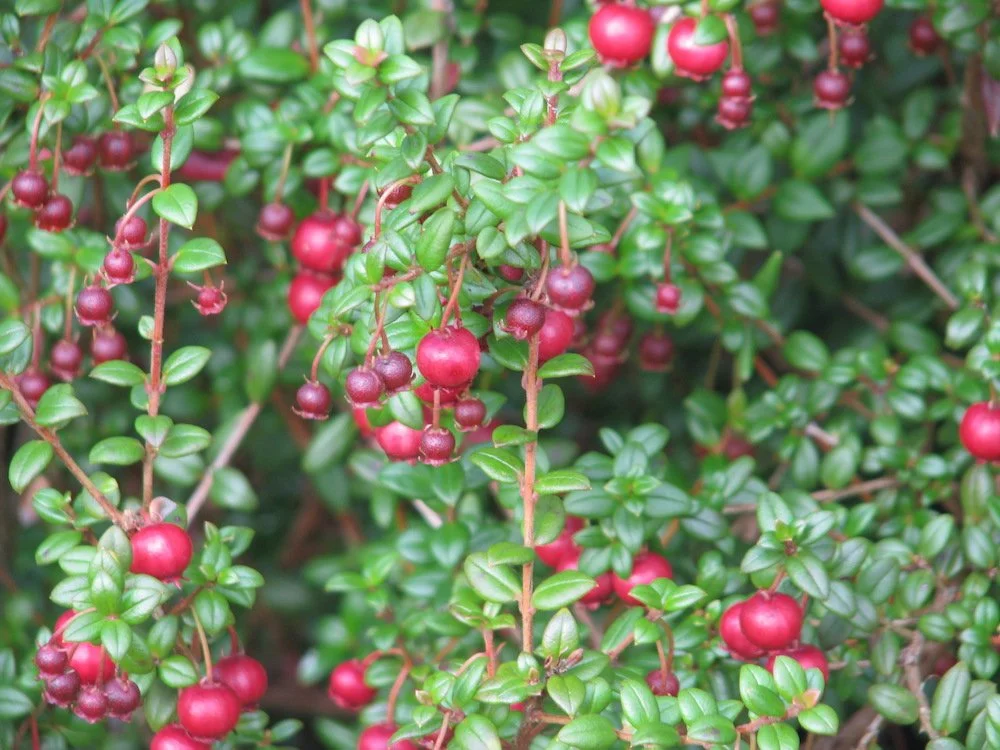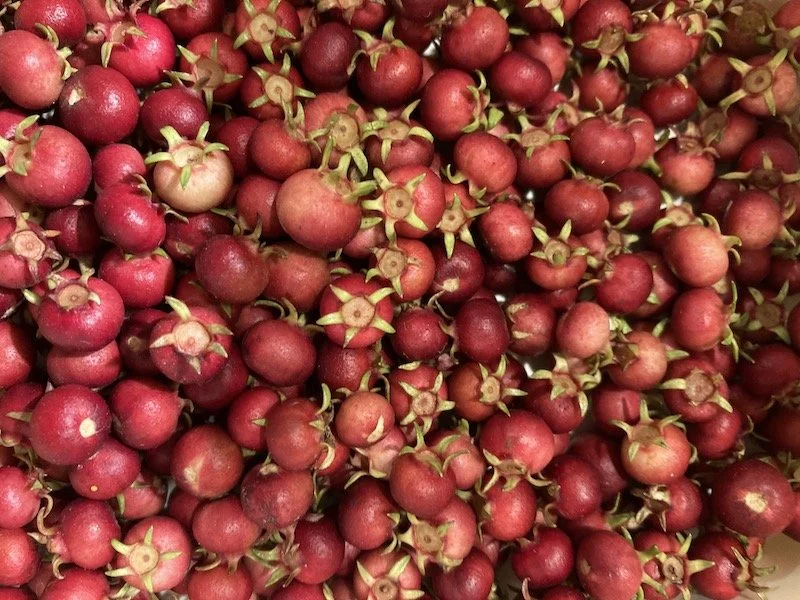Fruit trees from South America
Join us on an amazing trip to the South American ‘corner’ of the Orchard and explore the wonderful and diverse edible species to be found there. Learn about their names, varieties and edibility purposes.
If you wish to know more about each of the many many different species and varieties present at the Orchard of Flavours, feel free to dive into the complete database. Or even better, come for a visit and get to know us!
Looking for a particular edible species? Save yourself some scrolling time by using the shortcuts below (by botanical name):
Acca sellowiana
Feijoa, pineapple guava, goyavier du Brésil, goyave-ananas
Edible parts:
The feijoa fruit, which matures in autumn, is green, ellipsoid, and about the size of a chicken egg. It has a sweet, aromatic flavour, which tastes like pineapple, apple and mint. The flesh is juicy.
Varieties at the Orchard:
Mammoth, Apollo, Coolidge, Gemini, Marian
Aloysia citriodora
Verveine du Perou, lemon verbena, lúcia-lima
Edible parts:
Leaves are occasionally cooked as a spinach. More commonly used as a flavouring in green salads, fruit salads, etc. A delicious lemon-like flavour, it is adored by most people who try it. A delicious and refreshing tea is made from the leaves.
Annona cherimola
Cherimoya, chirimoya, churimoya, custard apple
Edible parts:
Raw fruit has a delicious flavour, tasting like a cross between a banana and a pineapple. The white flesh of the ripe cherimoya is sweet, juicy and very fragrant. It is most commonly eaten out of-hand or scooped with a spoon from the cut open fruit. It can also be used in making ice cream, custard, cakes etc.
Varieties at the Orchard:
Alboran: A new variety of Cherimoya for off-season production (during the winter and spring months).
Annona glabra
Pond apple, alligator apple, annone des marais
Edible parts:
The pulp is eaten raw or made into jellies or drinks. Best eaten when fully ripe and soft. Highly fragrant.
Annona montana
Mountain soursop, wild soursop, cachiman morveux
Edible parts:
The fruits are consumed fresh for dessert when fully ripe or mixed with ice cream or milk to make a drink. Immature fruits, harvested when the seeds are still soft, are cooked as a vegetable in soups.
Annona mucosa
Biriba, wild sweetsop, rollinier, corossol sauvage
Edible parts:
The edible, yellow fruit has an excellent quality and can be used in ice cream, pies and cakes. The seeds have wide range of uses like as a material in making necklaces and bracelets, and as an insecticide.
Annona squamosa
Custard apple, pomme canelle, sugar apple
Edible parts:
The raw fruits are sweet and creamy, they are highly regarded as a dessert fruit. They can also be used to make sherbet, ice cream, jellies etc. The fruit is up to 10cm in diameter.
Anredera cordifolia
Madeira-vine, mignonette-vine
Edible parts:
The root is eaten raw or cooked. Boiled and eaten like potatoes. Leaves are eaten raw or cooked. Succulent and slightly mucilaginous. Eaten in salads or cooked as a potherb. Used as a spinach.
Aristotelia chilensis
Macqui, Chilean wineberry
Edible parts:
The purplish to black fruit is rather small, about 6mm. Eaten raw or dried for winter. Sweet and refreshing, like bilberries, with a slight astringency. A popular nonfermented drink, 'chicha de maqui', is made from the berries. The fruit is simply mashed and mixed with water and the liquid drawn off and drunk.
Bixa orellana
Roucou, achiote, lipsticktree, urucum, annatto
Edible parts:
In Brazil, a powder known as colorau or colorífico is made from the ground seeds combined with filler seeds like maize. This powder is similar to and sometimes replaces paprika.
Bunchosia argentea
Peanut butter fruit, ciruela del monte, usuma, manteiga-de-amendoim
Edible parts:
The raw fruit has a sticky, dense, sweet, pleasant-tasting pulp. About the size of a quail egg, the reddish-orange fruit is not very juicy but has concentrated sugars like a dried fig or an American persimmon. Some people have compared the fruit to a cooked sweet potato, whilst it is also sometimes called the peanut butter fruit because its texture, but not its taste, is similar to peanut butter. The broadly ovoid fruit is about 23mm in diameter.
Bunchosia armeniaca
Bunchosie abricot, cansaboca, ciruela de fraile, guaimaro, indano, cold-earth mamey
Edible parts:
The round, light green to orange fruits have a cream-coloured flesh that is very sweet and rather cloying. The flesh is sweet but thin and rather dry. The fruit, which is 25 - 40mm in diameter, is produced in clusters of 8 - 10. Usually eaten out of hand, they are also made into preserves.
Butia capitata
Jelly palm, palmier à vin, palmier abricot, palmier vinaigre, arbre à laque
Edible parts:
Sweet and aromatic with the flavour of apricots. They can also be made into jellies, jams, pies, cakes etc. The fruit is very fibrous but is also very nice. The seed contains up to 45% of an edible oil, it is used mainly for margarines.
Ceiba pentandra
Arbre à Kapok, fromager, arbre coton
Edible parts:
Tender leaves, buds and fruit are mucilaginous and are eaten like okra. A pleasant tasting cooking oil is extracted from the seed. The dried stamens are added to curries and hot, sour soup for colouring. Kapok is the vegetable fiber from the fruit of this tree, it generally replaces cotton.
Cnidoscolus aconitifolius
Chaya, tree spinach
Edible parts:
When cooked, the young leaves and shoots of tree spinach are consumed as vegetable as it is rich in protein, calcium, iron, carotene, riboflavin, niacin, and ascorbic acid. It should be noted however that leaves should be cooked thoroughly to remove its high hydrocyanic acid content. Minimum 15 minutes !!
Eugenia brasiliensis
Grumichama, Brazilian cherry, Brazilian plum, Spanish cherry
Edible parts:
Fruit can be eaten raw or used in jams, jellies etc. The deep crimson fruit has a thin and delicate skin, soft and melting pulp and a mild subacid taste. The taste largely resides in the skin. Excellent when eaten fresh. The persistent sepals ('rabbit ears') and the modest flesh to seed ratio limit the appeal of the fruit. The fruit is a globose to oblate berry, up to 3 - 5cm in diameter.
Eugenia candolleana
Rainforest plum, cambuí roxo
Edible parts:
The fruit is moderately sweet, with an aroma similar to (but less intense than) that of the jabuticaba. The fruit are consumed fresh or made into jams.
Eugenia involucrata
Cereja do Rio Grande, cherry of the Rio Grande
Edible parts:
A thick, fleshy, succulent pulp with a very pleasant, sweet or subacid flavour.
Eugenia pyriformis
Uvaia, uvalha
Edible parts:
The fruits have a thick, very succulent pulp with a sweet or acid flavour. The yellow, aromatic fruit varies in shape from globose to pear-shaped. Due to acid taste, uvaia fruits are usually consumed in the form of juices, vinegars, beers, liqueurs, jellies, sweets, yogurts and ice cream.
Eugenia uniflora
Pitanga, cayenne cherry, Suriname cherry
Edible parts:
The edible fruit is a botanical cherry. The taste ranges from sweet to sour, depending on the cultivar and level of ripeness (the darker red to black range is quite sweet, while the green to orange range is strikingly tart). Its predominant food use is as a flavoring and base for jams and jellies. The fruit is high in vitamin C and a source of vitamin A. The leaves are used as a substitute for tea.
Varieties at the Orchard:
Black
Garcinia humilis
Bacupari, achacha
Edible parts:
The aril-like translucent subacid white pulp has an excellent flavour, suggesting that of the mangosteen. A highly prized fruit, usually eaten fresh but also makes an excellent jam. The ovate fruit may be 32 - 40mm long, with an orange-yellow, pliable, leathery, tough skin, 3mm thick that is easily removed.
Hylocereus undatus
Dragon fruit, pitaya, pitaia, queen of the night
Edible parts:
Dragon fruit taste has been described as a slightly sweet cross between a kiwi and a pear.
Varieties at the Orchard:
Pink
Inga edulis
Ice cream bean, guama, cuaniquil
Edible parts:
The pulp surrounding the seeds in the seedpod is white, translucent and jelly-like with a sweet, perfumed flavour that resembles the taste of vanilla ice cream. Much esteemed in Ecuador, some forms have a slight cinnamon flavour. The seedpod is up to 100cm long. The beans are also used in traditional medicines for treating dysentery, diarrhea, and reliving arthritic joints pains.
Monstera deliciosa
Ceriman, swiss-cheese plant, split-leaf philodendron, costela de Adão, fruto delicioso
Edible parts:
The fruit of Monstera deliciosa is up to 25 cm long and 3–5 cm diameter, and it looks like a green ear of maize covered with hexagonal scales. The smell has been compared to a combination of pineapples and bananas. The fruit is edible and safe for humans. Unripe fruit can cause irritation of the mouth. More than a year for fruits to reach maturity. The fruit first shows signs of ripening by the yellowing of its lowest scales.
Myrcianthes pungens
Guabiyu
Edible parts:
The fruit is succulent and the juicy pulp has a sweet flavor.
Passiflora edulis
Passion fruit, maracujá, purple granadilla
Edible parts:
The pulp is the edible part of the fruit and has a soft sweet taste. It is very aromatic and contains vitamins A, C, and K, phosphorus, iron, and calcium.
Passiflora ligularis
Sweet granadilla
Edible parts:
The pulp is the edible part of the fruit and has a soft sweet taste. It is very aromatic and contains vitamins A, C, and K, phosphorus, iron, and calcium.
Pereskia aculeata
Carne de pobre, ora-pro-nóbis, Barbados gooseberry, blade apple
Edible parts:
Young shoots and leaves, eaten raw or cooked, contain high quantities of protein (20 to 30% of protein in the dry leaf matter), iron and other nutrients. They can be eaten in salads in the same way as purslane (Portulacca spp.), or added to cooked dishes and eaten as greens. They are an important food in parts of rural Brazil. Fruits are generally stewed or preserved with sugar, or made into jam.
Peumus boldus
Boldo, boldo do Chile
Edible parts:
Leaves are used for culinary purposes, or herbal tea. Fruit is eaten raw or cooked. Sweet and aromatic with an agreeable flavour. The fruit is up to 2cm in diameter. The leaves and bark are used as a condiment.
Physalis peruviana
Groundcherry, Cape gooseberry, goldenberry
Edible parts:
Once extracted from its husk, it can be eaten raw and used in salads. Some varieties are added to desserts, used as flavoring, made into fruit preserves, or dried and used like raisins.
Plinia cauliflora
Jaboticaba, Brazilian grapetree
Edible parts:
The fruit can be eaten raw, made into jellies, syrups and preserves or fermented into wine. The purplish, grape-like fruit has a thick skin with a translucent, juicy pulp and a pleasant vinous flavour. In both taste and appearance they are remarkably like some cultivars of the muscadine grape. The fruit is rich in vitamin C.
Plumeria rubra
Frangipani, frangipanier, Hawaiian lei flower
Edible parts:
Although the white sap of the stem is clearly toxic, the flowers do not seem to be toxic and we found a few recipe of fried plumeria flowers. The oil of the colorful flower, also known as the Hawaiian Lei flower, has been used in perfumery since the 16th century.
Pouteria lucuma
Lucuma
Edible parts:
The fruit can be eaten raw. It is also dried and made into a meal that can be added to wheat flour, cornmeal or starch and used in making a range of drinks and desserts. The meal adds a strong odour and colour to ice cream, sherbets, puddings etc. The fruit has a green to brownish green pulp that is dry and firm in texture with a very rich, sweet flavour that is somewhat reminiscent of a baked sweet potato. The ovate fruit is 4 - 8cm long.
Psidium cattleianum
Cattley guava, strawberry guava, cherry guava, goyavier de Chine, araçá
Edible parts:
Cattley guava is eaten raw or cooked. The fruit can be used in jellies, jams, custards, drinks etc. Sweet and aromatic. The flavour is more pronounced than that of the yellow strawberry guava but lacks the muskiness of the common guava. The fruit has an agreeable acid-sweet flavour and is good when eaten raw, though it can also be used in preserves.
Schinus molle
False pepper, Peruvian pepper, faux poivrier odorant
Edible parts:
Although it is not a true pepper, its dried drupes are often sold as pink peppercorns. The seeds can be used as a spice, adding a pepper-like taste to food.
Schinus terebinthifolius
Baie rose des iles, Brazilian peppertree, christmasberry tree
Edible parts:
Although it is not a true pepper, its dried drupes are often sold as pink peppercorns, as are the fruits from the related species Schinus molle (Peruvian pepper). The seeds can be used as a spice, adding a pepper-like taste to food.
Solanum betaceum
Tamarilho, tomate en arbre, tree tomato
Edible parts:
The fruit has a slightly resinous aroma and the flavor suggests a mild or underripe tomato with a faintly resinous aftertaste. While the skin is somewhat tough and unpleasant in flavor, the outer layer of flesh is slightly firm, succulent and bland, and the pulp surrounding the seeds in the two lengthwise compartments is soft, juicy, subacid to sweet; it is black in dark-purple and red fruits, yellow in yellow and orange fruits.
Solanum muricatum
Poire-melon, melon pear, pêra melão, melão andino, sweet cucumber
Edible parts:
A juicy, sweet aromatic and very agreeable flavour somewhat like a honeydew melon. The skin of some varieties has a disagreeable flavour. The fruit should be harvested just before it is fully ripe and will store for several weeks at room temperature.
Solanum quitoense
Naranjilla, lulo
Edible parts:
The fruit is eaten raw or cooked. The hairs on the skin of the mature fruit are removed before the fruit is eaten. It is mainly used in sauces and preserves, the tart yet sweet flavour is very refreshing. The pulp is very juicy similar to a cherry tomato. The juice, which is rich in protein and minerals, is used in effervescent drinks.
Solanum sisymbriifolium
Litchi tomato, vila-vila, sticky nightshade, fire and ice plant, morelle de Balbis
Edible parts:
The small edible fruits are red on the outside and yellow inside. It grows inside a spiny, green husk. The fruit is ripe when it is easily removed from the stem. The flavor resembles sour cherries and a little bit like a tomato.
Stevia rebaudiana
Candyleaf, sweetleaf, sugarleaf, stevia
Edible parts:
Stevia leaves are considered to be anywhere between 10 to 300 times sweeter than traditional white sugar, yet they contain neither calories nor carbohydrates.
Ugni molinae
Chilean guava, strawberry myrtle, New Zealand cranberry
Edible parts:
Fruit is eaten raw or cooked. An absolutely delicious flavour, it is very aromatic and tastes of wild strawberries. Leaves are a tea substitute. The roasted seeds are a coffee substitute.
Varieties at the Orchard:
Elite

